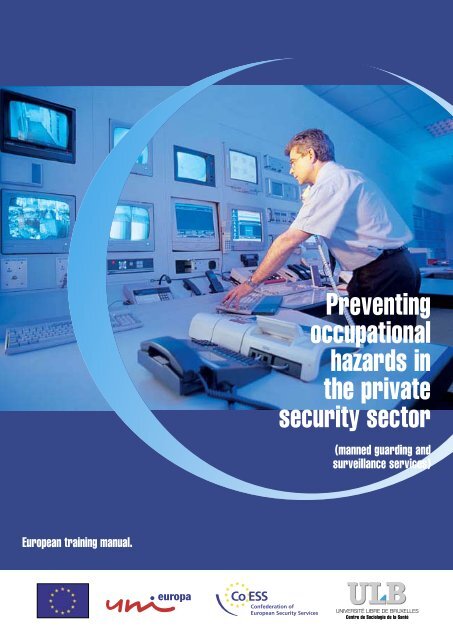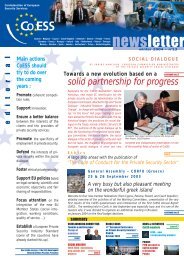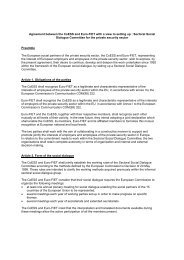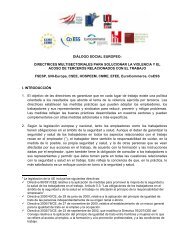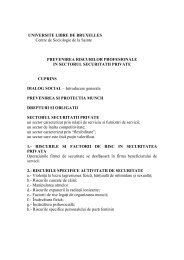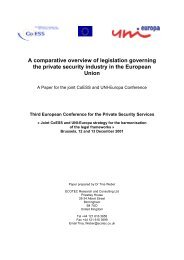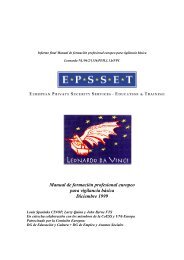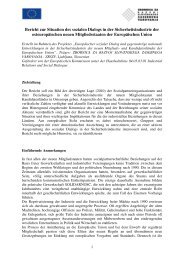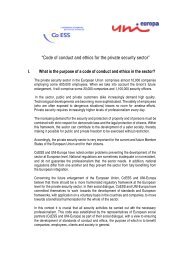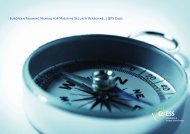Preventing occupational hazards in the private security sector - CoESS
Preventing occupational hazards in the private security sector - CoESS
Preventing occupational hazards in the private security sector - CoESS
Create successful ePaper yourself
Turn your PDF publications into a flip-book with our unique Google optimized e-Paper software.
Social dialogue<strong>Prevent<strong>in</strong>g</strong> <strong>occupational</strong> <strong>hazards</strong> is oneof <strong>the</strong> important issues on <strong>the</strong> agendaof <strong>the</strong> social partners <strong>in</strong> this <strong>sector</strong>. Thisconcern is also borne out by <strong>the</strong> fact thatthis item is often mentioned <strong>in</strong> jo<strong>in</strong>t publicationsand declarations:“In certa<strong>in</strong> functions of <strong>the</strong> <strong>private</strong> <strong>security</strong><strong>sector</strong>, <strong>the</strong>re are considerable <strong>occupational</strong><strong>hazards</strong> to be reckoned with. Them<strong>in</strong>imum health and safety standards for<strong>private</strong> <strong>security</strong> guards must at least beapplied <strong>in</strong> all companies <strong>in</strong> <strong>the</strong> <strong>sector</strong> <strong>in</strong>order to ensure <strong>the</strong> maximum possibleprevention of <strong>occupational</strong> <strong>hazards</strong>.These standards should be regularlyrevised <strong>in</strong> consultation with social partnersand competent authorities, <strong>in</strong> order toguarantee <strong>the</strong> health and safety of <strong>security</strong>personnel”.Code of conduct and ethics for<strong>the</strong> <strong>private</strong> <strong>security</strong> <strong>sector</strong>The safety of employees“<strong>Prevent<strong>in</strong>g</strong> <strong>occupational</strong> <strong>hazards</strong> is oneof <strong>the</strong> most important aspects of <strong>the</strong>organization of work <strong>in</strong> <strong>the</strong> <strong>private</strong> <strong>security</strong><strong>sector</strong>. Tra<strong>in</strong><strong>in</strong>g is essential <strong>in</strong> this area,as is <strong>the</strong> development of techniques andprocedures which guarantee, to <strong>the</strong> greatestextent possible, <strong>the</strong> safety of workersexposed to dangerous situations (…)”.M<strong>in</strong>imiz<strong>in</strong>g <strong>the</strong> risks“All workers <strong>in</strong> <strong>the</strong> <strong>sector</strong> must be givenappropriate tra<strong>in</strong><strong>in</strong>g <strong>in</strong> <strong>the</strong> best practices<strong>in</strong> <strong>the</strong> field of health and safety;this reduces <strong>the</strong> risks to which <strong>the</strong>y areexposed and allows <strong>the</strong>m to carry outmore efficiently <strong>the</strong>ir mission of protect<strong>in</strong>gpeople and property”.The issues and results of European socialdialogue <strong>in</strong> <strong>the</strong> <strong>private</strong> <strong>security</strong> <strong>sector</strong>The social partners <strong>in</strong> <strong>the</strong> <strong>private</strong> <strong>security</strong><strong>sector</strong> at European level felt that it wasextremely important to have a basic tra<strong>in</strong><strong>in</strong>gtool for health and safety, which iscommon to all EU countries and whichcomplements <strong>the</strong> European VocationalTra<strong>in</strong><strong>in</strong>g Manual for Basic Guard<strong>in</strong>g.General<strong>in</strong>troductionThis manual is <strong>the</strong> result of a study<strong>in</strong>volv<strong>in</strong>g several European countries.It is <strong>the</strong> outcome of research carriedout <strong>in</strong> close co-operation with socialpartners <strong>in</strong> <strong>the</strong> <strong>private</strong> <strong>security</strong> <strong>sector</strong>,which was <strong>in</strong>tended to determ<strong>in</strong>e <strong>the</strong>nature of <strong>occupational</strong> <strong>hazards</strong> <strong>in</strong> <strong>the</strong><strong>sector</strong>. This study <strong>in</strong>volved question<strong>in</strong>g<strong>the</strong> ma<strong>in</strong> players <strong>in</strong> <strong>the</strong> <strong>sector</strong>: employers,workers, prevention representatives andconsultants, etc. This manual conta<strong>in</strong>sessential <strong>in</strong>formation for understand<strong>in</strong>g<strong>the</strong> risks you face <strong>in</strong> do<strong>in</strong>g your joband <strong>the</strong> methods for prevent<strong>in</strong>g <strong>the</strong>m ordeal<strong>in</strong>g with <strong>the</strong>ir consequences.Focus<strong>in</strong>g on risks and risk factors mightgive a negative impression of <strong>the</strong> <strong>private</strong><strong>security</strong> <strong>sector</strong>, or ra<strong>the</strong>r, an impressionwhich is more negative than <strong>the</strong> actualreality. This is why we feel it useful to po<strong>in</strong>tout that work can also be a source ofwellbe<strong>in</strong>g and empowerment.This manual is common to all <strong>the</strong> countriesof <strong>the</strong> European Union and is <strong>the</strong>reforebased on <strong>the</strong> m<strong>in</strong>imum requirementsset out <strong>in</strong> <strong>the</strong> European laws known as“directives”, which all member states mustrespect. This means that, on certa<strong>in</strong> po<strong>in</strong>ts,<strong>the</strong> laws <strong>in</strong> your country may provide foradditional measures, but, whatever <strong>the</strong>case may be, <strong>the</strong> requirements <strong>in</strong> thismanual must be observed (1).In this manual we will be referr<strong>in</strong>g to“<strong>security</strong> guards”. This term, though, doesnot express <strong>the</strong> same idea <strong>in</strong> <strong>the</strong> differentcountries of <strong>the</strong> European Union. Wehave based ourselves on <strong>the</strong> def<strong>in</strong>itionof <strong>security</strong> guard given <strong>in</strong> <strong>the</strong> EuropeanVocational Tra<strong>in</strong><strong>in</strong>g Manual for BasicGuard<strong>in</strong>g.“Any person who is paid a wage, fee orsalary to perform one or more of <strong>the</strong> of <strong>the</strong>follow<strong>in</strong>g functions:– Prevention or detection of <strong>in</strong>trusion,unauthorized entry or activity,vandalism or trespass<strong>in</strong>g on <strong>private</strong>property.– Prevention or detection of <strong>the</strong>ft, loss,embezzlement, misappropriation orconcealment of merchandise, money,bonds, stocks, notes, valuablesdocuments or papers.– Protection of <strong>in</strong>dividuals from bodilyharm.– Adherence to, and enforcementof, established company rules,regulations, measures, policies andpractices related to crime reduction.– The report<strong>in</strong>g and apprehension ofviolators.– Report<strong>in</strong>g on <strong>in</strong>cidents and calls”.This manual has been compiled by <strong>the</strong>Centre de Sociologie de la Santé (C.S.S.)of <strong>the</strong> Université Libre de Bruxelles. Theproject has been carried out with <strong>the</strong>collaboration and under <strong>the</strong> supervisionof social dialogue partners from <strong>the</strong><strong>private</strong> <strong>security</strong> <strong>sector</strong> (<strong>CoESS</strong>, employersand UNI-Europa, trade unions) and <strong>the</strong>Directorate-General for Employmentand Social Affairs from <strong>the</strong> EuropeanCommission.(1) For each of <strong>the</strong> po<strong>in</strong>ts raised <strong>the</strong> reader willf<strong>in</strong>d a reference to <strong>the</strong> relevant Europeandirectives, which is <strong>in</strong>dicated by thissymbol:<strong>Prevent<strong>in</strong>g</strong> <strong>occupational</strong> <strong>hazards</strong> <strong>in</strong> <strong>the</strong> <strong>private</strong> <strong>security</strong> <strong>sector</strong> 5
The adverse effects that work canhave on health have serious consequences<strong>in</strong> terms of human andeconomic cost, not just for workersand <strong>the</strong>ir families but also for companiesand society as a whole. To deal with<strong>the</strong>se effects <strong>the</strong> European Union hasdeveloped a legal framework to preventrisks and promote health and safety atwork.European legislation obliges companiesto implement social policy focused onhuman be<strong>in</strong>gs as <strong>in</strong>dividuals <strong>in</strong> orderto improve <strong>the</strong> wellbe<strong>in</strong>g of workers as<strong>the</strong>y do <strong>the</strong>ir jobs. The cornerstone of allrequirements <strong>in</strong> <strong>the</strong> area of risk prevention<strong>in</strong> <strong>the</strong> workplace is someth<strong>in</strong>g called<strong>the</strong> framework directive. This directiveprovides a reference basis for a seriesof specific directives which cover all <strong>the</strong>risks related to health and safety <strong>in</strong> <strong>the</strong>workplace. Among o<strong>the</strong>r th<strong>in</strong>gs, it setsforth <strong>the</strong> obligations of employers andworkers with a view to improv<strong>in</strong>g healthand safety <strong>in</strong> <strong>the</strong> workplace.PREVENTION AND PROTECTION AT WORK: RIGHTS AND OBLIGATIONS— THE EMPLOYER— THE WORKERS— THE CLIENT (PRINCIPAL)7
Prevention and protection at work: rights and obligationsTHE EMPLOYERThe employer is obliged to guarantee <strong>the</strong>health and safety of workers <strong>in</strong> all aspectsrelated to <strong>the</strong> job and noth<strong>in</strong>g can relieve<strong>the</strong> employer of this responsibility.As part of <strong>the</strong>se responsibilities, <strong>the</strong>employer must take <strong>the</strong> necessary precautionsto protect <strong>the</strong> health and safetyof workers, <strong>in</strong>clud<strong>in</strong>g action to prevent<strong>occupational</strong> <strong>hazards</strong>, <strong>in</strong>form<strong>in</strong>g andtra<strong>in</strong><strong>in</strong>g staff, and sett<strong>in</strong>g up <strong>the</strong> necessaryorganizational structure and meansto achieve <strong>the</strong>se aims. The employermust modify <strong>the</strong>se measures to take <strong>in</strong>toaccount changes <strong>in</strong> circumstances andmust try to improve exist<strong>in</strong>g situations.1 <strong>Prevent<strong>in</strong>g</strong> risks.GENERAL OBLIGATIONS OF EMPLOYERS2 Evaluat<strong>in</strong>g <strong>the</strong> risks which cannot be prevented.3 Combat<strong>in</strong>g risks at source.4 Adapt<strong>in</strong>g work to <strong>the</strong> <strong>in</strong>dividual– Mak<strong>in</strong>g sure that <strong>the</strong> structure of jobs, organization, <strong>the</strong> choice ofequipment, substances and procedures alleviate <strong>the</strong> monotony of <strong>the</strong> jobto be carried out with a view to reduc<strong>in</strong>g ill effects on health.5 Tak<strong>in</strong>g <strong>in</strong>to account technical developments (e.g. ergonomic mach<strong>in</strong>ery,tools and appliances).6 Replac<strong>in</strong>g what is hazardous by what is not hazardous, or by what isless hazardous.7 Plann<strong>in</strong>g risk prevention by tak<strong>in</strong>g <strong>in</strong>to account technology, organizationof work, work<strong>in</strong>g conditions, social relationships and <strong>the</strong> <strong>in</strong>fluence of factorsrelated to <strong>the</strong> work<strong>in</strong>g environment.8 Giv<strong>in</strong>g collective protective measures priority over <strong>in</strong>dividual protectivemeasures.9 Giv<strong>in</strong>g appropriate <strong>in</strong>structions to workers to guarantee <strong>the</strong>ir health andsafety at work.THE DIFFERENT OBLIGATIONS OF YOUR EMPLOYERYour employer must :A Conduct a risk evaluation for health and safety at work.B Determ<strong>in</strong>e what protection measures are to be taken and, if necessary, whatk<strong>in</strong>d of protective equipment is to be used.C Ma<strong>in</strong>ta<strong>in</strong> a register of accidents at work which have led to a period of<strong>in</strong>capacity for work of longer than three work<strong>in</strong>g days.D Draw up reports on accidents at work suffered by <strong>the</strong> firm’s workers.8 Relevant directive: 89/391/CEE <strong>Prevent<strong>in</strong>g</strong> <strong>occupational</strong> <strong>hazards</strong> <strong>in</strong> <strong>the</strong> <strong>private</strong> <strong>security</strong> <strong>sector</strong>
Prevention and protection at work: rights and obligationsTHE WORKERSOn your side, too, you have a greatresponsibility <strong>in</strong> terms of protect<strong>in</strong>g yourhealth and safety, as well as that of yourco-workers and o<strong>the</strong>r people <strong>in</strong>volved <strong>in</strong>your activities and professional tasks. So,you should take care of yourself and ofo<strong>the</strong>rs <strong>in</strong> accordance with <strong>the</strong> tra<strong>in</strong><strong>in</strong>g and<strong>in</strong>structions you have received from youremployer. It is important for you to collaborateactively <strong>in</strong> your company’s healthand safety policy.The framework directive covers o<strong>the</strong>r generalpr<strong>in</strong>ciples concern<strong>in</strong>g <strong>the</strong> <strong>in</strong>formation,consultation and participation of workers,tra<strong>in</strong><strong>in</strong>g workers and <strong>the</strong>ir representatives,medical supervision and general guidel<strong>in</strong>esfor implement<strong>in</strong>g <strong>the</strong>se pr<strong>in</strong>ciples(see pages 52 to 55).You must :WORKERS’ OBLIGATIONSA Correctly use mach<strong>in</strong>ery, appliances, tools, transport equipment, etc.B Correctly use personal protective equipment supplied to you.C Not remove <strong>the</strong> safety devices for specific mach<strong>in</strong>ery and <strong>in</strong>stallationsand you must use <strong>the</strong>m correctly.D Report immediately to your employer and/or supervisors about any worksituation pos<strong>in</strong>g a serious and immediate danger to health and safetyand about any shortcom<strong>in</strong>gs <strong>in</strong> protection arrangements.E Perform all tasks set forth by safety regulations and cooperate with <strong>the</strong>employer to ensure a work<strong>in</strong>g environment and conditions that do not poseany risks <strong>in</strong> terms of health and safety.THE CLIENT (THE PRINCIPAL)The client must take appropriate measuresso that employers of workers from anyexternal <strong>security</strong> undertak<strong>in</strong>gs engaged<strong>in</strong> work <strong>in</strong> his or her company receive,<strong>in</strong> accordance with national laws and/orpractices, adequate <strong>in</strong>formation concern<strong>in</strong>ghealth and safety risks and concern<strong>in</strong>gprotective and preventive measuresand actions for both <strong>the</strong> company and/orestablishment <strong>in</strong> general and every k<strong>in</strong>d ofpost and/or position <strong>in</strong> said undertak<strong>in</strong>g.The client must ensure that workers from<strong>security</strong> firms engaged <strong>in</strong> work <strong>in</strong> his orher company and/or establishment have<strong>in</strong> fact received appropriate <strong>in</strong>structionsregard<strong>in</strong>g health and safety risks dur<strong>in</strong>g<strong>the</strong>ir activities with <strong>the</strong> client company.COOPERATION AND CONSULTATION BETWEEN EMPLOYERS(client – guard<strong>in</strong>g services company)When workers of several companies are operat<strong>in</strong>g <strong>in</strong> <strong>the</strong> sameworkplace, employers must :A Co-operate <strong>in</strong> implement<strong>in</strong>g health, safety and <strong>occupational</strong> hygieneprovisions, tak<strong>in</strong>g <strong>in</strong>to account <strong>the</strong> nature of <strong>the</strong> activities.B Co-ord<strong>in</strong>ate <strong>the</strong>ir actions <strong>in</strong> matters of protection from, and prevention of,<strong>occupational</strong> <strong>hazards</strong>.C Inform each o<strong>the</strong>r of <strong>the</strong>se risks.D Inform <strong>the</strong>ir respective workers and/or workers’ representatives of <strong>the</strong>serisks.Prevention and protection at work: rights and obligations 9
The <strong>private</strong><strong>security</strong> <strong>sector</strong>
The reasons for expansion <strong>in</strong> <strong>the</strong> <strong>private</strong><strong>security</strong> <strong>sector</strong> are well known:an <strong>in</strong>crease <strong>in</strong> a feel<strong>in</strong>g of <strong>in</strong><strong>security</strong><strong>in</strong> society as a whole, result<strong>in</strong>g <strong>in</strong> ademand for <strong>security</strong> on <strong>the</strong> part of companies,public <strong>in</strong>stitutions and <strong>private</strong><strong>in</strong>dividuals, and, above all, <strong>the</strong> processof outsourc<strong>in</strong>g <strong>security</strong> operations whichwere previously performed by <strong>the</strong> public<strong>sector</strong> or public adm<strong>in</strong>istration. At <strong>the</strong>same time as this process of expansion,efforts have been made to professionalize<strong>the</strong> <strong>sector</strong> fur<strong>the</strong>r and <strong>the</strong>re has beengreater concern about improv<strong>in</strong>g work<strong>in</strong>gconditions, particularly <strong>in</strong> <strong>the</strong> areaof <strong>occupational</strong> hazard prevention. Anyimprovements made to health and safetyrequire action at three levels.1 – At <strong>sector</strong> level. At this level, it isimportant to take <strong>in</strong>to account all of<strong>the</strong> elements that make up <strong>the</strong> social,economic, legal, etc. context <strong>in</strong> which<strong>the</strong> <strong>private</strong> <strong>security</strong> activity is develop<strong>in</strong>g.These <strong>in</strong>clude, <strong>in</strong> no particular order,those to do with <strong>the</strong> job and work<strong>in</strong>gtime, access to <strong>the</strong> profession with<strong>in</strong> <strong>the</strong><strong>sector</strong>, competition between clients (pr<strong>in</strong>cipals)and <strong>security</strong> companies, tra<strong>in</strong><strong>in</strong>gand <strong>in</strong>formation for <strong>security</strong> personnel <strong>in</strong>risk prevention, presence of trade unions<strong>in</strong> companies and at <strong>sector</strong> level, etc.2 – At company level <strong>in</strong> <strong>the</strong> broadsense of <strong>the</strong> term, i.e. as a network<strong>in</strong>corporat<strong>in</strong>g workers of different statusfrom different organizations.At this level, it is a question of consider<strong>in</strong>g,amongst o<strong>the</strong>r th<strong>in</strong>gs, risk preventionmechanisms and company policy<strong>in</strong> <strong>the</strong> areas of risk prevention, humanresources management, tra<strong>in</strong><strong>in</strong>g, conflictmanagement, communication, etc.3 – At <strong>the</strong> level of organizationalrestrictions imposed <strong>in</strong> <strong>the</strong> workplaceitself. How is <strong>the</strong> team managed?What is <strong>the</strong> work<strong>in</strong>g atmospherelike? How much <strong>in</strong>dependence do <strong>the</strong>workers enjoy? Does <strong>the</strong> client fulfil his orher responsibilities <strong>in</strong> terms of health andsafety <strong>in</strong> <strong>the</strong> workplace? etc.Given that this manual is <strong>in</strong>tended aboveall for company workers, risk preventionrepresentatives and <strong>security</strong> managers,it focuses on <strong>the</strong> company or bus<strong>in</strong>essitself and <strong>the</strong> different k<strong>in</strong>ds of assignments.However, it is essential to keep<strong>in</strong> m<strong>in</strong>d <strong>the</strong> wider context of <strong>the</strong> <strong>private</strong><strong>security</strong> <strong>sector</strong>. We would also like tostress certa<strong>in</strong> general <strong>sector</strong> characteristicswhich have an effect on <strong>the</strong> healthand safety of workers and which requirepreventive measures to be adoptedthroughout <strong>the</strong> <strong>sector</strong>. Such measuresrequire, on <strong>the</strong> one hand, prior dialogue<strong>in</strong> companies or between <strong>the</strong> <strong>sector</strong>’ssocial partners, and, on <strong>the</strong> o<strong>the</strong>r, actionat <strong>in</strong>stitutional and political levels.THE PRIVATE SECURITY SECTORA <strong>sector</strong> characterized by service relationships and service provisionA highly competitive <strong>sector</strong>A <strong>sector</strong> characterized by “flexibility”A <strong>sector</strong> which is still undervalued11
The <strong>private</strong> <strong>security</strong> <strong>sector</strong>A SECTOR CHARACTERIZED BYSERVICE RELATIONSHIPS ANDSERVICE PROVISIONThe <strong>private</strong> <strong>security</strong> <strong>sector</strong> is characterizedby subcontract<strong>in</strong>g. Today, an <strong>in</strong>creas<strong>in</strong>gnumber of companies tend to subcontract<strong>security</strong> activities. The nature of thisservice relationship is def<strong>in</strong>itive <strong>in</strong> analys<strong>in</strong>grisk prevention problems. Involv<strong>in</strong>g <strong>the</strong>client <strong>in</strong> risk prevention policy is essentialif <strong>occupational</strong> <strong>hazards</strong> are to be tackled.From this perspective, any measure<strong>in</strong>tended to oblige clients to assumeresponsibilities <strong>in</strong> terms of risk preventionshould be encouraged.A HIGHLY COMPETITIVE SECTORCompetition <strong>in</strong> <strong>the</strong> <strong>sector</strong> is known to bevery tough. Contracts for <strong>private</strong> <strong>security</strong>services are often awarded to <strong>the</strong> cheapestoffer (‘<strong>the</strong> lowest bid’) ra<strong>the</strong>r than to<strong>the</strong> best offer (‘<strong>the</strong> best bid’), i.e. <strong>the</strong> oneguarantee<strong>in</strong>g a high quality service andgood work<strong>in</strong>g conditions, as well as compliancewith collective agreements, labourlaws and obligations and responsibilities<strong>in</strong> terms of risk prevention and health atwork. The unfair competition which isbecom<strong>in</strong>g apparent dur<strong>in</strong>g <strong>the</strong> award<strong>in</strong>gof contracts damages <strong>the</strong> image of<strong>the</strong> <strong>sector</strong> (amateurism, illegal practices,etc.) and has a negative impact on <strong>the</strong>health and safety of workers. It is formallycondemned by <strong>the</strong> social partners, whohave published a manual (1) on award<strong>in</strong>gcontracts <strong>in</strong> order to prevent it from happen<strong>in</strong>g.(1) Choos<strong>in</strong>g <strong>the</strong> best quality/price ratio. A manualfor public authorities award<strong>in</strong>g contracts forguard<strong>in</strong>g services, <strong>CoESS</strong> - UNI-Europa 1999(www.securebestvalue.org).12 <strong>Prevent<strong>in</strong>g</strong> <strong>occupational</strong> <strong>hazards</strong> <strong>in</strong> <strong>the</strong> <strong>private</strong> <strong>security</strong> <strong>sector</strong>
The <strong>private</strong> <strong>security</strong> <strong>sector</strong>A SECTOR CHARACTERIZED BY“FLEXIBILITY”A SECTOR WHICH IS STILLUNDERVALUEDThe <strong>private</strong> <strong>security</strong> <strong>sector</strong> is characterizedby <strong>the</strong> flexible way <strong>in</strong> which <strong>the</strong> workis organized. This k<strong>in</strong>d of organization wasadopted <strong>in</strong> order to provide 24-hour a day,7-day a week services and to meet <strong>the</strong>varied requests made by <strong>sector</strong> clients.This flexibility can be observed at differentlevels:– Flexibility <strong>in</strong> <strong>the</strong> number of employees,which is l<strong>in</strong>ked to <strong>the</strong> ability of companiesto vary <strong>the</strong> number of workers <strong>the</strong>yemploy depend<strong>in</strong>g on fluctuations <strong>in</strong>demand– Flexibility <strong>in</strong> work<strong>in</strong>g time (such as nonstandardforms of work<strong>in</strong>g time, nightand weekend shifts, overtime, standby)– Flexibility <strong>in</strong> terms of <strong>the</strong> tasks to beperformed by workers, who have to beable at all times to adapt to <strong>the</strong> needsof companies and clients <strong>in</strong> order tocomply with varied and unpredictabledemands. Companies <strong>in</strong>creas<strong>in</strong>gly relyon <strong>the</strong>ir workers show<strong>in</strong>g <strong>in</strong>itiative.Guard<strong>in</strong>g companies <strong>in</strong> general and <strong>security</strong>guards <strong>in</strong> particular help to makepublic places secure and contribute to <strong>the</strong>creation of a safer society so that publicand <strong>private</strong> freedoms can be enjoyedwithout constra<strong>in</strong>ts. This contribution,though, is not always fully appreciated.This under-valu<strong>in</strong>g of <strong>the</strong> <strong>sector</strong> reflectsa certa<strong>in</strong> degree of ignorance and lackof recognition of <strong>the</strong> work carried outby <strong>security</strong> companies and <strong>the</strong>ir staff,which can have negative implications for<strong>the</strong> image of <strong>the</strong> <strong>sector</strong> and <strong>the</strong>refore for<strong>the</strong> professional identity of its workers.For <strong>the</strong> <strong>sector</strong> to receive <strong>the</strong> recognitionit deserves, <strong>in</strong>itiatives could be taken toraise awareness of <strong>the</strong> social role playedby <strong>private</strong> <strong>security</strong> and thus project a betterimage of <strong>the</strong> <strong>sector</strong>.Thus, whe<strong>the</strong>r it is because of <strong>the</strong> work<strong>in</strong>ghours, <strong>the</strong> type of contract or <strong>the</strong> typeof service that is required of <strong>the</strong> workers,it is clear that <strong>the</strong> <strong>sector</strong> is a highly flexibleone. This has a major impact on <strong>the</strong>biological and social rhythms and familysituations of <strong>private</strong> <strong>security</strong> guards andleads to considerable mental and emotionalstra<strong>in</strong>.The <strong>private</strong> <strong>security</strong> <strong>sector</strong> 13
Risks andrisk factors<strong>in</strong> <strong>private</strong><strong>security</strong>
In compil<strong>in</strong>g this manual, wedecided to restrict ourselvesto sett<strong>in</strong>g out risks [*] neutrallywithout attempt<strong>in</strong>g to classify<strong>the</strong>m <strong>in</strong> terms of seriousness. Theaim of <strong>the</strong> manual here is to:– <strong>in</strong>form you (and raise yourawareness) about <strong>the</strong> risks yourun <strong>in</strong> do<strong>in</strong>g your job– help you to identify <strong>the</strong> <strong>hazards</strong>which you are exposed to– <strong>in</strong>form you about preventivemeasures to be adopted– <strong>in</strong>form you about <strong>the</strong> consequencesand negative effectson health and safety if <strong>the</strong>serisks become realities.The list of risks <strong>in</strong> this manualdoes not <strong>in</strong>clude all <strong>the</strong> riskswhich exist. O<strong>the</strong>r risks may wellbe determ<strong>in</strong>ed as a result of<strong>the</strong> risk assessment procedureswhich your company must carryout regularly. The frameworkdirective makes risk assessmenta necessary tool for ensur<strong>in</strong>g <strong>the</strong>safety and protect<strong>in</strong>g <strong>the</strong> healthof workers. It must be structuredand implemented <strong>in</strong> sucha way as to help employers todeterm<strong>in</strong>e what <strong>hazards</strong> exist andevaluate <strong>the</strong> risks associated with<strong>the</strong>se <strong>hazards</strong> <strong>in</strong> order to decidewhich measures to adopt to protect<strong>the</strong> health and guarantee <strong>the</strong>safety of <strong>the</strong>ir employees.The aim of preventionis not just to preventaccidents but also anyfactor harmful to healthresult<strong>in</strong>g from work.We chose to divide <strong>security</strong>-relatedrisks <strong>in</strong>to three broad categories:1. Risks result<strong>in</strong>g from <strong>the</strong>general situation2. Specific risks related to<strong>security</strong> activities3. Risks related to <strong>the</strong> pos<strong>the</strong>ld.We chose to use a very generalway to present <strong>the</strong> risks. Basedon <strong>the</strong> three categories mentionedabove, for each one wehave specified whe<strong>the</strong>r <strong>the</strong> riskconcerns all types of <strong>security</strong>guards or certa<strong>in</strong> specific activities.Risks are always presented, withoutexception, <strong>in</strong> <strong>the</strong> same way.Firstly, <strong>the</strong>re is a brief <strong>in</strong>troductionabout <strong>the</strong> nature of <strong>the</strong> risk. Then<strong>the</strong>re is an analysis of <strong>the</strong> risk factors<strong>in</strong>volved and a presentationof risk prevention measures to beadopted by <strong>the</strong> actor <strong>in</strong>volved:client, employer or worker. F<strong>in</strong>ally,<strong>the</strong>re is an explanation of whateffect it would have if <strong>the</strong> riskbecame a reality.The risks are, <strong>in</strong> <strong>the</strong>ory, dealt withon an equal foot<strong>in</strong>g: none is givenmore importance than ano<strong>the</strong>reven if some of <strong>the</strong>m concernonly a very limited number ofguards or represent a low accidentor health risk.Some risks are only brieflydescribed whilst more attentionis devoted to o<strong>the</strong>rs because of<strong>the</strong>ir greater complexity.[*] Def<strong>in</strong>ition. Risk can bedef<strong>in</strong>ed as <strong>the</strong> probability (potentiality)of a certa<strong>in</strong> level of damage,tak<strong>in</strong>g <strong>in</strong>to account exposure to arisk factor and <strong>the</strong> probabilityof damage occurr<strong>in</strong>g dur<strong>in</strong>g <strong>the</strong>exposure period.RISKS AND RISK FACTORS IN PRIVATE SECURITY1. RISKS RESULTING FROM THE GENERAL SITUATION 162. SPECIFIC RISKS RELATED TO SECURITY ACTIVITIES 17A. Violence at work (physical attack, bully<strong>in</strong>g, sexual harassment) 17B. Risks posed by dogs 21C. Handl<strong>in</strong>g weapons 22D. Risks related to exposure to radiation 23E. Risk factors related to work organization 24F. The physical workload 27G. The psychosocial workload 31H. Specific risks fac<strong>in</strong>g female <strong>security</strong> personnel 373. RISKS RELATED TO THE POST HELD 38A. Safety risks 381. Risk of falls, slips and trips 392. Risk of collisions, bumps and jamm<strong>in</strong>g 403. Risk of road accidents 414. Risk of electrical accidents 425. Risk of fire 43B. Risks related to <strong>the</strong> work<strong>in</strong>g environment 441. Physical <strong>hazards</strong> 452. Biological <strong>hazards</strong> 483. Chemical <strong>hazards</strong> 4915
1. Risks result<strong>in</strong>g from <strong>the</strong> general situation1. Risks result<strong>in</strong>gfrom <strong>the</strong> generalsituationBy risks result<strong>in</strong>g from <strong>the</strong> generalsituation, we mean <strong>the</strong> risks l<strong>in</strong>ked to<strong>the</strong> context <strong>in</strong> which <strong>security</strong> activityis carried out. Hence, <strong>the</strong> referencesphere is <strong>the</strong> <strong>sector</strong>, its ma<strong>in</strong> actors(<strong>security</strong> company, client) and <strong>the</strong>relationships between <strong>the</strong>m.Here we are tak<strong>in</strong>g <strong>in</strong>to account <strong>the</strong>risks associated with <strong>the</strong> operationsof <strong>the</strong> <strong>security</strong> company carried outwith<strong>in</strong> <strong>the</strong> client company (<strong>the</strong> pr<strong>in</strong>cipal).SECURITY COMPANY OPERATIONSWITHIN THE CLIENT COMPANYThese are ma<strong>in</strong>ly <strong>in</strong>terference risks, additionalrisks on top of those risks <strong>in</strong>herent<strong>in</strong> <strong>the</strong> activity of each company and <strong>the</strong>yare due to <strong>the</strong> <strong>in</strong>stallations, equipmentand activities of various companies <strong>in</strong> <strong>the</strong>same workplace.When workers from different companiesare <strong>in</strong>volved <strong>in</strong> <strong>the</strong> same work<strong>in</strong>g environment,work<strong>in</strong>g relationships becomemore complex and may complicate <strong>the</strong>coord<strong>in</strong>ation of activities. This may result<strong>in</strong> disorganization, with everyth<strong>in</strong>g thisentails <strong>in</strong> terms of accidents and confusionconcern<strong>in</strong>g <strong>the</strong> tasks to be executed,etc. In <strong>the</strong>se k<strong>in</strong>ds of circumstances,efforts must <strong>the</strong>refore be made at companylevel <strong>in</strong> order to share <strong>in</strong>formationand to reach an agreement on respectiveduties and responsibilities.RISK FACTORSPREVENTIVE MEASURESEFFECTS ON HEALTHThis <strong>in</strong>terference riskensues from a lack ofknowledge at two levels:lack of knowledge ofone company regard<strong>in</strong>g<strong>the</strong> risks of <strong>the</strong>o<strong>the</strong>r companylack of knowledge relatedto jo<strong>in</strong>t activity andjo<strong>in</strong>t operations.Your employer and <strong>the</strong> client must :Cooperate <strong>in</strong> implement<strong>in</strong>g health, safety and<strong>occupational</strong> hygiene provisions.Coord<strong>in</strong>ate <strong>the</strong>ir actions <strong>in</strong> matters of protectionfrom, and prevention of, <strong>occupational</strong> <strong>hazards</strong>.Inform each o<strong>the</strong>r of <strong>the</strong>se risks.Inform <strong>the</strong>ir respective workers and/or workers’representatives of <strong>the</strong>se risks.You must :Take care of yourself and of o<strong>the</strong>rs <strong>in</strong>accordance with <strong>the</strong> tra<strong>in</strong><strong>in</strong>g and <strong>in</strong>structionsyou have received from your employer and/orfrom <strong>the</strong> client.Collaborate actively <strong>in</strong> <strong>the</strong> health and safetypolicy <strong>in</strong> your company.The <strong>in</strong>terference risk is basically an accidentrisk l<strong>in</strong>ked to <strong>the</strong> operations of <strong>the</strong><strong>security</strong> company carried out with<strong>in</strong> <strong>the</strong>client company. However, it also constitutesa possible factor of uncerta<strong>in</strong>ty,tension and stress for <strong>security</strong> guardsto <strong>the</strong> extent that <strong>the</strong>y f<strong>in</strong>d <strong>the</strong>mselves<strong>in</strong> work<strong>in</strong>g situations/contexts <strong>in</strong> which<strong>the</strong>y have no knowledge of <strong>the</strong> risksresult<strong>in</strong>g from <strong>the</strong>se situations, of <strong>the</strong>preventive measures to be adopted,or of <strong>the</strong> responsibilities of <strong>the</strong> people<strong>the</strong>y deal with.16 <strong>Prevent<strong>in</strong>g</strong> <strong>occupational</strong> <strong>hazards</strong> <strong>in</strong> <strong>the</strong> <strong>private</strong> <strong>security</strong> <strong>sector</strong>
2. Specific risks related to <strong>security</strong> activities2. Specific risksrelated to <strong>security</strong>activitiesBy <strong>the</strong> term “risks specific to <strong>security</strong>activities”, what we mean are those risksthat are often called “<strong>in</strong>herent risks” orrisks specifically l<strong>in</strong>ked to <strong>the</strong> activity and/or organization of work <strong>in</strong> companies.Given <strong>the</strong> diversity of <strong>security</strong> activity andservices, some of <strong>the</strong> risks mentionedaffect all <strong>private</strong> <strong>security</strong> staff, while o<strong>the</strong>rsonly affect a few highly specific posts.Risks which are specific to <strong>security</strong> activitiesare divided <strong>in</strong>to <strong>the</strong> follow<strong>in</strong>g categories:A. Violence at work.B. Risks posed by dogs.C. Handl<strong>in</strong>g weapons.D. Exposure to radiation.E. Risk factors related to workorganization.F. The physical workload.G. The psychosocial workload.H. Specific risks fac<strong>in</strong>g female <strong>security</strong>personnel.A. VIOLENCE AT WORKViolence <strong>in</strong> <strong>the</strong> workplace may come <strong>in</strong>many guises:– verbal violence: <strong>in</strong>sults, threats– physical violence: be<strong>in</strong>g struck or be<strong>in</strong>g<strong>in</strong>jured– by weapons or by giv<strong>in</strong>g <strong>the</strong>impression of be<strong>in</strong>g armed– discrim<strong>in</strong>ation on <strong>the</strong> grounds of race,sk<strong>in</strong> colour, ethnic orig<strong>in</strong>, sex, religionor sexual orientation– sexual harassment– bully<strong>in</strong>g– …Risks and risk factors <strong>in</strong> <strong>private</strong> <strong>security</strong> 17
Specific risks related to <strong>security</strong> activitiesRISK OF PHYSICAL ATTACKFor obvious reasons, <strong>the</strong>re is ahigh risk of physical aggression<strong>in</strong> <strong>the</strong> <strong>sector</strong>, even if it is difficultto assess how probable or dangerousthis risk is <strong>in</strong> advance.Indeed, <strong>the</strong>re is a wide rangeof situations <strong>in</strong> which acts ofphysical aggression are committedaga<strong>in</strong>st <strong>security</strong> guards.The magnitude of <strong>the</strong> problemis confirmed by several studieswhich list <strong>security</strong> personnelas be<strong>in</strong>g among <strong>the</strong> <strong>occupational</strong>groups most likely to beexposed to acts of physicalaggression.These attacks constitute an<strong>occupational</strong> hazard and thusaffect all <strong>security</strong> guards.However, some jobs are saidto be more exposed to physicalviolence than o<strong>the</strong>rs, for <strong>in</strong>stance,those that <strong>in</strong>volve contactwith <strong>the</strong> public: surveillance ofshopp<strong>in</strong>g centres, or areas witha high through-flow of people(underground stations, railwaystations, etc.), detection of shoplift<strong>in</strong>g,etc.RISK FACTORSSome characteristicsof <strong>the</strong> workplace:isolated, very busy(communication hubs,shopp<strong>in</strong>g centres),without a <strong>security</strong>system, etc.Possibilities forimmediate or veryquick communicationwith o<strong>the</strong>r people(colleagues, police, yourcompany, etc.).The nature of <strong>the</strong> jobor post: lone work<strong>in</strong>g,night/day shifts, contactwith <strong>the</strong> public, etc.The assailant(s)(del<strong>in</strong>quents, clients,service users, etc.):number, physicalfeatures, <strong>the</strong> fact that<strong>the</strong>y may be under <strong>the</strong><strong>in</strong>fluence of alcoholor drugs, <strong>the</strong> level ofaggressiveness andviolence, whe<strong>the</strong>r or not<strong>the</strong>y are armed, etc.The <strong>security</strong> guard:tra<strong>in</strong><strong>in</strong>g and experience<strong>in</strong> deal<strong>in</strong>g with <strong>the</strong>sek<strong>in</strong>ds of situations, his/her reactions, excess/lack of confidence, etc.Your employer must :PREVENTIVE MEASURESTake <strong>in</strong>to account all exist<strong>in</strong>g <strong>security</strong> measures (codeddoors, bolt<strong>in</strong>g entries, etc.).Ensure that quick communication is possible if a problemarises (telephone, radio, alarm buttons, etc.).Keep <strong>the</strong> number of lone workers to a m<strong>in</strong>imum and, ifthis proves impossible, make sure that <strong>the</strong> employee hasa means of constant contact with <strong>the</strong> central office.Tra<strong>in</strong> staff <strong>in</strong> handl<strong>in</strong>g conflict situations: tra<strong>in</strong><strong>in</strong>g <strong>in</strong> <strong>the</strong>early detection of potential assailants (identify<strong>in</strong>g patternsof behaviour and signs of a possible attack), conflict managementtra<strong>in</strong><strong>in</strong>g (learn<strong>in</strong>g how to deal with difficult situations<strong>in</strong>volv<strong>in</strong>g clients and service users, and learn<strong>in</strong>g howto cope with <strong>the</strong> tension related to such situations with aview to controll<strong>in</strong>g any emotional reactions).Your employer ought to consider :Not leav<strong>in</strong>g a guard who has been a victim of, or witnessto, a violent act alone <strong>in</strong> <strong>the</strong> period follow<strong>in</strong>g <strong>the</strong> <strong>in</strong>cidentand, if necessary, provid<strong>in</strong>g <strong>the</strong>m with psychological help.Tra<strong>in</strong><strong>in</strong>g some workers <strong>in</strong> listen<strong>in</strong>g and provid<strong>in</strong>g supportto staff members who have been physically attacked.…You must :Follow <strong>the</strong> <strong>in</strong>structions and tra<strong>in</strong><strong>in</strong>g you have been given.Not expose yourself to danger recklessly. Act cautiously.Assess <strong>the</strong> situation properly before tak<strong>in</strong>g action andabove all avoid play<strong>in</strong>g down <strong>the</strong> risks of any actiontaken.Communicate as quickly as possible <strong>the</strong> correct andaccurate nature of any situation. (location, circumstance,etc.) which is out of <strong>the</strong> ord<strong>in</strong>ary or potentially dangerous.Make sure that your communication equipment is always<strong>in</strong> good work<strong>in</strong>g order and with<strong>in</strong> easy reach.…EFFECTS ON VICTIMSThe nature and seriousness of <strong>in</strong>juries can vary considerably depend<strong>in</strong>g on <strong>the</strong> nature of <strong>the</strong>attack:Light <strong>in</strong>juries: superficial lesions, blows and light traumas (bruises, scratches, etc.).Serious <strong>in</strong>juries: serious traumas and <strong>in</strong>juries requir<strong>in</strong>g surgery or result<strong>in</strong>g <strong>in</strong> possible lossof life.Death.In addition to <strong>the</strong>se <strong>in</strong>juries, physical attacks may also have o<strong>the</strong>r negative effects on workers’health:reduced psychological wellbe<strong>in</strong>g and <strong>in</strong>creased risk of psychological problemscognitive effects, such as concentration problemslow self-esteemlack of job satisfaction and motivationfeel<strong>in</strong>gs of fearpost-traumatic stress.18 <strong>Prevent<strong>in</strong>g</strong> <strong>occupational</strong> <strong>hazards</strong> <strong>in</strong> <strong>the</strong> <strong>private</strong> <strong>security</strong> <strong>sector</strong>
Specific risks related to <strong>security</strong> activitiesRISK OF SEXUAL HARASSMENTSexual harassment refers to “<strong>the</strong> situation<strong>in</strong> which unwanted behaviour witha sexual connotation, expressed physically,verbally or non-verbally, occurs withan aim or effect which is harmful to <strong>the</strong>personal dignity of an <strong>in</strong>dividual and,more specifically, creates an <strong>in</strong>timidat<strong>in</strong>g,hostile, degrad<strong>in</strong>g, humiliat<strong>in</strong>g or <strong>in</strong>sult<strong>in</strong>genvironment.”Companies are becom<strong>in</strong>gly <strong>in</strong>creas<strong>in</strong>glyaware of sexual harassment <strong>in</strong> <strong>the</strong> workplace.There is a prevalent belief which does notcorrespond to reality: that victims of sexualharassment are always women. It is truethat sexual harassment is a phenomenonwhich predom<strong>in</strong>antly affects women, butmen can also be victims of this k<strong>in</strong>d ofharassment.Fur<strong>the</strong>rmore, a range of studies carried out<strong>in</strong>to sexual harassment <strong>in</strong> EU countries alltend to show that sexual harassment ismore common <strong>in</strong> professions where as<strong>in</strong>gle gender dom<strong>in</strong>ates (whe<strong>the</strong>r it bemen or women) than it is <strong>in</strong> those where<strong>the</strong>re is a balanced proportion of menand women. As <strong>the</strong> <strong>security</strong> <strong>sector</strong> is atypically male <strong>sector</strong>, sexual harassmentcould well turn out to be a considerablerisk for female <strong>security</strong> guards.EFFECTS ON HEALTHOn a psychological level, sexual harassmentmay result <strong>in</strong> stress, anxiety,depression, a state of nervousness,feel<strong>in</strong>gs of despair, impotence, anger,etc. The physical effects of sexualharassment <strong>in</strong>volve sleep<strong>in</strong>g and eat<strong>in</strong>gdisorders, headaches, nausea,high blood pressure - <strong>in</strong> fact, all <strong>the</strong>symptoms commonly associated withstress.Risks and risk factors <strong>in</strong> <strong>private</strong> <strong>security</strong> Relevant directive : 2002/73/CE 19
Specific risks related to <strong>security</strong> activitiesRISK OF BULLYINGBully<strong>in</strong>g <strong>in</strong> <strong>the</strong> workplace is taken to mean“abnormal, repeated behaviour directedaga<strong>in</strong>st a worker or group of workerswhich results <strong>in</strong> a risk to health and safety.(…) which may manifest itself throughverbal as well as physical aggression, butalso through more subtle acts, such asunderrat<strong>in</strong>g an employee’s work or isolat<strong>in</strong>g<strong>the</strong> <strong>in</strong>dividual socially.” (1).As far as bully<strong>in</strong>g <strong>in</strong> <strong>the</strong> workplace isconcerned, <strong>the</strong>re are two very frequentlyencountered excesses that must be prevented:1. Interpret<strong>in</strong>g every conflict <strong>in</strong> <strong>the</strong>workplace between co-workers,between a staff member and his orher superior, between a guard and<strong>the</strong> client, etc. as an act of bully<strong>in</strong>g…There are numerous def<strong>in</strong>itions of bully<strong>in</strong>gbut all of <strong>the</strong>m conta<strong>in</strong> three dimensionsthat serve to dist<strong>in</strong>guish bully<strong>in</strong>g from anyo<strong>the</strong>r type of violence <strong>in</strong> <strong>the</strong> workplace:– <strong>the</strong> repeated and susta<strong>in</strong>ed nature of<strong>the</strong> acts– <strong>the</strong> impact, which is always negative,devastat<strong>in</strong>g and destructive, on <strong>the</strong>person targeted– <strong>the</strong> perpetrator’s (or perpetrators’) wishto cause harm.Some attitudes and types of behaviour(such as authoritarian attitudes and shout<strong>in</strong>g,etc.) do not constitute bully<strong>in</strong>g if <strong>the</strong>irroot cause is not spite or if <strong>the</strong>y are notregularly repeated. However, given that<strong>the</strong>y can also poison <strong>the</strong> atmosphereat work, <strong>the</strong>y are also to be prohibited.Moreover, <strong>the</strong>se k<strong>in</strong>ds of attitudes caneasily develop <strong>in</strong>to bully<strong>in</strong>g.This dist<strong>in</strong>ction is important because <strong>the</strong>fact of be<strong>in</strong>g considered as be<strong>in</strong>g bulliedor not has very different implications <strong>in</strong>terms of <strong>the</strong> law and how <strong>the</strong> victim isdealt with.2. Only analys<strong>in</strong>g potential casesof bully<strong>in</strong>g <strong>in</strong> <strong>in</strong>dividual terms, <strong>in</strong>terms of <strong>in</strong>compatibilities betweenpeople or groups of people.It is perfectly possible that a disagreementor misunderstand<strong>in</strong>g between people is at<strong>the</strong> orig<strong>in</strong> of <strong>the</strong> bully<strong>in</strong>g but more oftenthan not its cause is rooted <strong>in</strong> o<strong>the</strong>rcircumstances. Numerous studies havedemonstrated that <strong>the</strong>re is a correlationbetween bully<strong>in</strong>g and certa<strong>in</strong> organizationalfeatures specific to <strong>the</strong> company <strong>in</strong>question. The risk factors which can leadto bully<strong>in</strong>g could <strong>in</strong>clude:– possible areas of doubt regard<strong>in</strong>gtasks to be performed <strong>in</strong> a work setupbased on flexibility– bad work<strong>in</strong>g atmosphere, conflictsbetween co-workers withoutmeasures be<strong>in</strong>g taken to remedy <strong>the</strong>situation– confusion/conflicts <strong>in</strong> terms ofhierarchic responsibilities– authoritarian management style– dehumanised management andsocial relations– bad relationship betweenmanagement and workers– fail<strong>in</strong>gs <strong>in</strong> staff management policies– …It should be remembered that whatever<strong>the</strong> cause of bully<strong>in</strong>g, it is up to <strong>the</strong> companyto f<strong>in</strong>d a solution. On no accountshould it refra<strong>in</strong> from act<strong>in</strong>g.EFFECTS ON HEALTHBully<strong>in</strong>g, amongst o<strong>the</strong>r effects onhealth, may result <strong>in</strong> stress, depression,loss of self-esteem, feel<strong>in</strong>gs of guilt,phobias, sleep and eat<strong>in</strong>g disorders,etc. The consequences of <strong>the</strong>seconditions can range from depressionto suicide and <strong>in</strong>clude addiction topharmaceutical drugs.(1) European Agency for Health and Safety <strong>in</strong><strong>the</strong> Workplace, Bully<strong>in</strong>g at work, Factsheet23.Your employer must:Send a clear message to potentialperpetrators and victims: violence, <strong>in</strong>whatever form, will not be acceptedor tolerated.Specify <strong>the</strong> obligations of <strong>the</strong>hierarchy <strong>in</strong> prevent<strong>in</strong>g possiblesituations of this k<strong>in</strong>dInvestigate <strong>the</strong> facts quickly andimpartially.Make sure that compla<strong>in</strong>ts do notlead to reprisals.Ma<strong>in</strong>ta<strong>in</strong> <strong>the</strong> anonymity of bothvictims and perpetrators.Inform and tra<strong>in</strong> workers regard<strong>in</strong>g<strong>the</strong> risks and preventive measures tobe adopted.…PREVENTIVE MEASURES FOR BULLYING AND SEXUAL HARASSMENTYour employer ought to consider:Appo<strong>in</strong>t<strong>in</strong>g one or more trustworthypeople to provide “front l<strong>in</strong>e” contact<strong>in</strong> deal<strong>in</strong>g with, and provid<strong>in</strong>gsupport for, <strong>the</strong> victims.Sett<strong>in</strong>g up mechanisms to deal withvictims and to re<strong>in</strong>tegrate <strong>the</strong>m <strong>in</strong> <strong>the</strong>workplace.You must:Communicate immediately that youf<strong>in</strong>d a situation or type of behaviourunacceptable.Not let problems develop.Speak openly about <strong>the</strong> problemwith <strong>the</strong> colleagues that you workwith.Ma<strong>in</strong>ta<strong>in</strong> a critical distance (do nottry to f<strong>in</strong>d reasons to justify <strong>the</strong> wayyou are be<strong>in</strong>g treated).Inform <strong>the</strong> personnel or humanresources manager/ <strong>the</strong> preventionrepresentative.If you are not <strong>the</strong> only person<strong>in</strong>volved, request that yourcompany’s managers carry out an<strong>in</strong>quiry and take steps to f<strong>in</strong>d asolution.…20 <strong>Prevent<strong>in</strong>g</strong> <strong>occupational</strong> <strong>hazards</strong> <strong>in</strong> <strong>the</strong> <strong>private</strong> <strong>security</strong> <strong>sector</strong>
Specific risks related to <strong>security</strong> activitiesB. RISKS POSED BY DOGSUs<strong>in</strong>g dogs can represent a health hazardfor dog handlers.The use of dogs entails risks of accidents(bites, etc.) as well as biological risksl<strong>in</strong>ked to exposure to biological agents,i.e. microorganisms that may cause <strong>in</strong>fections,allergies or poison<strong>in</strong>g. These microorganismsmay penetrate <strong>the</strong> human bodythrough a wound or mucous membranes,or follow<strong>in</strong>g an animal bite. They may alsobe <strong>in</strong>haled or swallowed.The risks result<strong>in</strong>g from <strong>the</strong> use of dogsare peculiar to <strong>the</strong> <strong>sector</strong> and ma<strong>in</strong>ly affectdog handlers, as well as <strong>security</strong> guardsthat are part of teams that use dogs.RISK FACTORSPREVENTIVE MEASURESNATURE OF INJURIESThe dog: badly tra<strong>in</strong>ed,too aggressive, sick,unpredictable behaviour.Bad dog handl<strong>in</strong>g:several dog handlersfor one and <strong>the</strong> samedog, different commandpatterns depend<strong>in</strong>gon <strong>the</strong> <strong>in</strong>dividual’s role,poor liv<strong>in</strong>g conditions,food and monitor<strong>in</strong>g of<strong>the</strong> health of <strong>the</strong> animal(vacc<strong>in</strong>ations, regularmedical check-ups).The dog-handler:untra<strong>in</strong>ed or poorlytra<strong>in</strong>ed as a dog handler,lack of compliance withbasic hygiene regulations,lack of care for <strong>the</strong> dog,aggressive or unsuitablebehaviour towards <strong>the</strong>dog.Your employer must :Make sure that dog handlers have done <strong>the</strong> compulsory tra<strong>in</strong><strong>in</strong>gand have <strong>the</strong> necessary certificates.Ensure that <strong>the</strong> dogs are properly tra<strong>in</strong>ed.Replace dogs that are no longer suitable (ei<strong>the</strong>r because <strong>the</strong>yhave become too aggressive or because <strong>the</strong>ir performance isbelow par).Ensure <strong>the</strong> dogs are housed and fed properly (clean and wellkeptkennels).Ensure that all <strong>the</strong> vacc<strong>in</strong>ation and hygiene requirements aremet.Make sure that if dogs are to be used by several dog handlers,measures are taken to ensure that only one set of commoncommands is used with <strong>the</strong> dog.…You must :Follow <strong>the</strong> <strong>in</strong>structions and tra<strong>in</strong><strong>in</strong>g you have been given.Respect <strong>the</strong> regulations on us<strong>in</strong>g leashes and muzzles.Protect any wounds or <strong>in</strong>juries you have to prevent microorganismsfrom penetrat<strong>in</strong>g your body.Respect basic hygiene conditions: no eat<strong>in</strong>g, dr<strong>in</strong>k<strong>in</strong>g orsmok<strong>in</strong>g without wash<strong>in</strong>g your hands first.Take good care of <strong>the</strong> dog and behave properly with it.Inform your employer about any <strong>in</strong>cidences of unpredictablebehaviour or any o<strong>the</strong>r factor concern<strong>in</strong>g <strong>the</strong> dog which couldendanger your health or safety or that of o<strong>the</strong>rs.…Dogs can cause slight<strong>in</strong>juries such as lesions,light traumas (scratches,bruises) and serious <strong>in</strong>juriessuch as bites, etc.They may also causediseases as a result of<strong>in</strong>fections and allergiescaused by bacteria,fungi, acarids and/orviruses.Risks and risk factors <strong>in</strong> <strong>private</strong> <strong>security</strong> Relevant directive : 90/679/CEE 21
Specific risks related to <strong>security</strong> activitiesWARNING SIGNSLaser beamRadioactive materialD. RISKS RELATED TO EXPOSURETO RADIATIONThe use of equipment which generatesradiation or work<strong>in</strong>g <strong>in</strong> areas close toradiation sources entails a risk of tissuebe<strong>in</strong>g destroyed and/or irreversible effectson health. The risk level varies accord<strong>in</strong>gto <strong>the</strong> dose of radiation absorbed.This risk is specific to certa<strong>in</strong> jobs whereX-ray mach<strong>in</strong>es are used: access control(airports, public build<strong>in</strong>gs, etc.), or <strong>the</strong>screen<strong>in</strong>g of mail, packages, suitcases,etc. However, it also affects guards who,dur<strong>in</strong>g <strong>the</strong>ir rounds <strong>in</strong> hospitals, nuclearpower plants, etc. may enter monitored orsecure areas.[*][*] Def<strong>in</strong>ition.Secure area : area subject to specialregulations <strong>in</strong>tended to provide protection fromradiation and to limit radioactive contam<strong>in</strong>ation.Access to <strong>the</strong>se areas is regulated.Monitored areas : area subject to suitablesurveillance <strong>in</strong> order to provide protection fromradiation.RISK FACTORSPREVENTIVE MEASURESNATURE OF INJURIESScanners - X-raydevices: faultydevices, <strong>in</strong>appropriateuse.Certa<strong>in</strong> highly specificworkplaces, e.g. <strong>in</strong>hospitals (radiology,nuclear medic<strong>in</strong>edepartments), nuclearpower plants, etc.The <strong>security</strong> guard: amember of staff whois not tra<strong>in</strong>ed <strong>in</strong> <strong>the</strong>use of X-ray mach<strong>in</strong>esand/or is not familiarwith <strong>the</strong> risks he orshe is runn<strong>in</strong>g; oris not aware of <strong>the</strong>dangers <strong>in</strong>volved <strong>in</strong>enter<strong>in</strong>g monitored/secure areas, nor <strong>the</strong>preventive measuresto be adopted.Your employer must :Tra<strong>in</strong> you to use X-ray mach<strong>in</strong>es and <strong>in</strong>form you of <strong>the</strong> risksand preventive measures to be taken.Ensure that <strong>the</strong>se types of mach<strong>in</strong>es are only operated bytra<strong>in</strong>ed personnel.Place <strong>the</strong> <strong>in</strong>struction manual as well as any documentationrelat<strong>in</strong>g to <strong>the</strong> use of <strong>the</strong> mach<strong>in</strong>e <strong>in</strong> close proximity to it.Have <strong>the</strong> sources monitored (to prevent leaks).Use type-approved mach<strong>in</strong>es (marked CE) or make sure that<strong>the</strong> mach<strong>in</strong>es be<strong>in</strong>g used comply with European regulations.Make sure that <strong>the</strong> equipment goes through its periodicaltechnical <strong>in</strong>spection.…The client must :Inform you and your employer about any radiaton sources at<strong>the</strong> place of work, about <strong>the</strong> risks associated with <strong>the</strong>m and<strong>the</strong> preventive measures to be adopted.You must :Avoid putt<strong>in</strong>g your hands <strong>in</strong>to <strong>the</strong> radiation tunnel.Communicate any anomaly <strong>in</strong> <strong>the</strong> function<strong>in</strong>g of <strong>the</strong> mach<strong>in</strong>e toyour superiors.When on duty <strong>in</strong> <strong>the</strong> radiological area you must observe <strong>the</strong>appropriate precautions and measures.Respect <strong>the</strong> warn<strong>in</strong>g signs situated <strong>in</strong> monitored/secure areas.Observe <strong>the</strong> <strong>in</strong>dications given when mov<strong>in</strong>g about monitored/secure areas.…The effects of radiationcan be hereditary (i.e.<strong>the</strong>y may be passed onto your children and tosubsequent generations).Over a certa<strong>in</strong> radiationthreshold, <strong>the</strong>re may beshort-term effects relat<strong>in</strong>gto cell lesions: <strong>the</strong> tissuemost vulnerable to radiationis reproductive tissue(radiation can lead totemporary or permanentsterility), tissue <strong>in</strong>volved<strong>in</strong> <strong>the</strong> form<strong>in</strong>g of bloodcells (spleen, bone marrow,etc.), <strong>the</strong> crystall<strong>in</strong>elens <strong>in</strong> <strong>the</strong> eye and <strong>the</strong>sk<strong>in</strong>. Unexpected effectsmay also occur with<strong>in</strong> agroup of <strong>in</strong>dividuals withidentical exposure levelswithout it be<strong>in</strong>g possibleto identify a threshold;<strong>the</strong>se <strong>in</strong>volve cancers andcerta<strong>in</strong> genetic anomalies(mutations).Risks and risk factors <strong>in</strong> <strong>private</strong> <strong>security</strong> Relevant directive : 96/29/Euratom 23
Specific risks related to <strong>security</strong> activitiesE. RISK FACTORS RELATED TOWORK ORGANIZATIONThis <strong>in</strong>volves health and safety <strong>hazards</strong>result<strong>in</strong>g from <strong>the</strong> way work is organized,whe<strong>the</strong>r at company or job level.— The dual hierarchy— Lone work<strong>in</strong>g— Work schedules— Human resources management— Tra<strong>in</strong><strong>in</strong>g and <strong>in</strong>formation <strong>in</strong> riskprevention— Work<strong>in</strong>g time.THE DUAL HIERARCHYPrivate <strong>security</strong> guards are <strong>in</strong> a ra<strong>the</strong>r specialsituation because <strong>the</strong>y carry out <strong>the</strong>irwork at <strong>the</strong> client’s premises. As such<strong>the</strong>y must respect a sort of dual hierarchy:on <strong>the</strong> one hand, <strong>the</strong>y have to meet<strong>the</strong> professional demands made on <strong>the</strong>mby <strong>the</strong>ir employer and, on <strong>the</strong> o<strong>the</strong>r, <strong>the</strong>yhave to meet <strong>the</strong> demands of <strong>the</strong>ir clients.In pr<strong>in</strong>ciple, <strong>the</strong> duties and obligations ofthose <strong>in</strong>volved (<strong>the</strong> client, <strong>the</strong> employer,<strong>the</strong> <strong>security</strong> guard) are clearly del<strong>in</strong>eated.However, <strong>in</strong> <strong>the</strong> field, <strong>the</strong> subcontract<strong>in</strong>grelationship may result <strong>in</strong> each party’sroles, duties and responsibilities becom<strong>in</strong>gblurred. This can lead to tension andmay cause considerable stress for <strong>security</strong>guards.The employer ought to consider:– Clarify<strong>in</strong>g <strong>the</strong> roles, obligations andresponsibilities of <strong>the</strong> employer, <strong>the</strong> clientand <strong>the</strong> worker– Improv<strong>in</strong>g communication, streng<strong>the</strong>n<strong>in</strong>g<strong>the</strong> presence and social support of<strong>the</strong> company for its workers.LONE WORKINGAlthough lone work<strong>in</strong>g is not prohibitedunder <strong>the</strong> European directives, it should<strong>in</strong> pr<strong>in</strong>ciple be subject to a prior riskassessment. If <strong>in</strong> <strong>the</strong> course of <strong>the</strong> riskassessment, it transpires that <strong>the</strong> <strong>security</strong>guard’s health and safety cannot be guaranteed,lone work<strong>in</strong>g should be avoided.If, conversely, <strong>the</strong> assessment reveals thatit is possible, <strong>the</strong> <strong>security</strong> guard must begiven all <strong>the</strong> necessary guarantees that heor she will be able to do <strong>the</strong> job <strong>in</strong> safetyand without health <strong>hazards</strong>.PREVENTIVE MEASURESYour employer must :Make sure that lone workers can get <strong>in</strong>touch with someone quickly.Guarantee regular supervision.Inform <strong>the</strong> worker about <strong>the</strong> risks he orshe may have to face.Make sure that workers are properlytra<strong>in</strong>ed so that <strong>the</strong>y can react satisfactorilyto unforeseen circumstances.Ensure that consultation with <strong>the</strong> clientcompany takes place at <strong>the</strong> time of <strong>the</strong>risk assessment so that all <strong>the</strong> risks<strong>in</strong>volved <strong>in</strong> lone work<strong>in</strong>g are clearlyidentified.…You must :Be able to notify somebody else rapidly(your company, <strong>the</strong> client company, <strong>the</strong>police).Make sure that your communicationequipment is always <strong>in</strong> good work<strong>in</strong>gorder and with<strong>in</strong> easy reach.Inform your supervisor about anyth<strong>in</strong>gwhich might entail a danger for health andsafety.…HAZARDS OF LONE WORKINGAttacks.Accidents or sickness whichmight require immediatehelp to be adm<strong>in</strong>istered.Inability to react correctly<strong>in</strong> emergency situations,unforeseen circumstancesand cases of physicalattack.24 Relevant directives : 89/391/CEE I 93/104/CEE I 2003/88/CEE <strong>Prevent<strong>in</strong>g</strong> <strong>occupational</strong> <strong>hazards</strong> <strong>in</strong> <strong>the</strong> <strong>private</strong> <strong>security</strong> <strong>sector</strong>
Specific risks related to <strong>security</strong> activitiesWORK SCHEDULESIn a <strong>sector</strong> like <strong>the</strong> <strong>security</strong> <strong>sector</strong> whichis based on flexibility it is sometimes difficult(<strong>in</strong> certa<strong>in</strong> jobs / activities) to providework schedules several months or weeks<strong>in</strong> advance. This problem is exacerbated byabsenteeism and o<strong>the</strong>r unknown organizationalfactors or unforeseen circumstances.Employers ought to try to devise and implementwork schedule management mechanismswhich allow <strong>security</strong> staff to organize<strong>the</strong>ir <strong>private</strong> lives better and/or to makearrangements for changes <strong>in</strong> duty rosterssufficiently <strong>in</strong> advance.HUMAN RESOURCES MANAGEMENTHuman resources management and organizationalculture may vary greatly from onecountry to <strong>the</strong> next, or from one companyto <strong>the</strong> next (e.g. small- and medium-sizedcompanies vs. mult<strong>in</strong>ational corporations).There is, however, a common characteristic:communication between <strong>private</strong> <strong>security</strong>staff and <strong>the</strong>ir hierarchy superiors is oftenlimited. The lack of direct contact may haveimplications on <strong>the</strong> quality of <strong>the</strong> communicationprocess and on <strong>the</strong> transfer of <strong>in</strong>formationand it could also <strong>in</strong>crease <strong>the</strong> guard’sfeel<strong>in</strong>g of isolation.The employer ought to consider:– Promot<strong>in</strong>g a management style whichtakes more account of <strong>the</strong> op<strong>in</strong>ions andcompla<strong>in</strong>ts of workers so that <strong>the</strong>y feel<strong>in</strong>tegrated and part of <strong>the</strong> company– Encourag<strong>in</strong>g <strong>the</strong> k<strong>in</strong>d of social contact andsupport which workers so often request <strong>in</strong><strong>the</strong> <strong>in</strong>spectors and supervisors (<strong>in</strong>termediatehierarchy) s<strong>in</strong>ce <strong>the</strong>se people havemore contact with workers.TRAINING AND INFORMATION IN RISKPREVENTIONThe lack of <strong>in</strong>formation about exist<strong>in</strong>grisks at your place of work and a lackof <strong>in</strong>formation necessary for carry<strong>in</strong>g outyour job can be <strong>the</strong> cause of accidentsat work and <strong>occupational</strong> illness, both foryou and for o<strong>the</strong>rs.PREVENTIVE MEASURESYour employer must :Inform you about <strong>the</strong> risks.Inform you about protective andpreventive measures and activitiesconcern<strong>in</strong>g both <strong>the</strong> establishmentwhere you are go<strong>in</strong>g to work and<strong>the</strong> job or function which you arego<strong>in</strong>g to have.Provide you with sufficient suitable<strong>in</strong>formation for your health andsafety.Provide tra<strong>in</strong><strong>in</strong>g which isspecifically geared towards <strong>the</strong> jobyou are to do or <strong>the</strong> function youare to carry out.Provide you with tra<strong>in</strong><strong>in</strong>g when:– you are hired– your functions adapt or change– changes occur <strong>in</strong> <strong>the</strong> equipmentyou work with– new technologies are<strong>in</strong>troduced.You must :As far as you are able, take careof your own health and safety <strong>in</strong>addition to that of people <strong>in</strong>volved<strong>in</strong> your actions or your professionaltasks, <strong>in</strong> accordance with <strong>the</strong>tra<strong>in</strong><strong>in</strong>g and <strong>in</strong>structions you havereceived from your employer.WORKING TIMETime spent at work <strong>in</strong> <strong>the</strong> <strong>private</strong> <strong>security</strong><strong>sector</strong> is atypical: night and weekendwork, shift work[*], long work<strong>in</strong>g daysand heavy weekly, monthly or overtimeworkloads.The follow<strong>in</strong>g are some of <strong>the</strong> effects ofwork<strong>in</strong>g hours on workers’ health:Eat<strong>in</strong>g disorders, sleep<strong>in</strong>gdisorders and fatigueA human be<strong>in</strong>g’s biological functions followa cycle of approximately twenty-fourhours. This cycle is called <strong>the</strong> circadiancycle or <strong>the</strong> biorhythm. Shift work andnight work are <strong>the</strong> cause of a whole seriesof harmful effects as both imply a lag <strong>in</strong><strong>the</strong> cycle:– Changes <strong>in</strong> eat<strong>in</strong>g patterns; differentmealtimes, often with a drop <strong>in</strong> <strong>the</strong>quality of <strong>the</strong> food - cold meals (sandwiches),fast eat<strong>in</strong>g, or not eat<strong>in</strong>g atregular times, etc. All of <strong>the</strong>se result <strong>in</strong>a nutritional imbalance, digestive disordersand <strong>in</strong>creased occurrence of obesity– Alterations to sleep<strong>in</strong>g patterns: disturbedsleep<strong>in</strong>g patterns, drop <strong>in</strong> <strong>the</strong>quality of sleep (noise, lights), and<strong>the</strong> number of hours’ sleep is oftenreduced– A reduction <strong>in</strong> recuperation time, whichresults <strong>in</strong> <strong>the</strong> <strong>in</strong>dividual be<strong>in</strong>g tired moreoften– Difficulties <strong>in</strong> rema<strong>in</strong><strong>in</strong>g awake on <strong>the</strong>job, which results <strong>in</strong> an <strong>in</strong>creased risk ofcommitt<strong>in</strong>g mistakes and thus becom<strong>in</strong>g<strong>the</strong> victim/cause of accidents.[*] Def<strong>in</strong>ition.Shift work : any method of organiz<strong>in</strong>g teamwork <strong>in</strong> which <strong>the</strong> workers take over successivelyfrom one ano<strong>the</strong>r <strong>in</strong> <strong>the</strong> same activityfollow<strong>in</strong>g a specific pattern, <strong>in</strong>clud<strong>in</strong>g shiftrotation, which can be cont<strong>in</strong>uous or not. Thismeans that a worker must do shifts at differenttimes over a specific period of days or weeks.Risks and risk factors <strong>in</strong> <strong>private</strong> <strong>security</strong> 25
Specific risks related to <strong>security</strong> activitiesF. THE PHYSICAL WORKLOADThese risks are general risks which affectall <strong>security</strong> guards, irrespective of <strong>the</strong> k<strong>in</strong>dof job <strong>the</strong>y do.The risk factors related to <strong>the</strong> physicalworkload are primarily l<strong>in</strong>ked to:A. Mov<strong>in</strong>g from place to placeB. Shift work, night workC. Forced or unsuitable work<strong>in</strong>gposturesWork<strong>in</strong>g postures often br<strong>in</strong>g about physicalfatigue and/or bodily harm: <strong>in</strong>juriesand lesions (result<strong>in</strong>g from be<strong>in</strong>g stuck,crushed or bump<strong>in</strong>g <strong>in</strong>to objects), fracturesand especially back pa<strong>in</strong>, and pa<strong>in</strong>sand discomfort <strong>in</strong> lower limbs (legs, feet).A. MOVING FROM PLACE TO PLACEMov<strong>in</strong>g around, especially on foot, as partof surveillance rounds may also constitutea significant physical stra<strong>in</strong>, particularly <strong>in</strong>view of <strong>the</strong> distances to be covered, <strong>the</strong>features of <strong>the</strong> site to be <strong>in</strong>spected, and<strong>the</strong> time allotted for rounds and breaks.B. SHIFT WORK AND NIGHT WORKTo <strong>the</strong> extent that shift work and nightwork have an impact on breaks, eat<strong>in</strong>gpatterns and sleep<strong>in</strong>g patterns, <strong>the</strong>yalso, directly or <strong>in</strong>directly, determ<strong>in</strong>e <strong>the</strong>physical workload of <strong>the</strong> job (see pages25-26).C. POSTURE AT WORKAs far as work<strong>in</strong>g postures are concerned,those which cause <strong>the</strong> greatestproblems are:– seated posture– a normal stand<strong>in</strong>g posture– postures <strong>in</strong>volved <strong>in</strong> <strong>the</strong> physicalhandl<strong>in</strong>g of loads.Generally, guards tend to change postureregularly but <strong>in</strong> some jobs <strong>the</strong>y spendmost of <strong>the</strong>ir day <strong>in</strong> <strong>the</strong> same position– ei<strong>the</strong>r stand<strong>in</strong>g or sitt<strong>in</strong>g.Risks and risk factors <strong>in</strong> <strong>private</strong> <strong>security</strong> 27
Specific risks related to <strong>security</strong> activitiesSeated posturesSeated postures are <strong>the</strong> most frequentones <strong>in</strong> activities <strong>in</strong>volv<strong>in</strong>g observ<strong>in</strong>gscreens or monitors as is <strong>the</strong> case <strong>in</strong><strong>security</strong> control centres, alarm controlcentres and certa<strong>in</strong> access control posts.These activities <strong>in</strong>volve not only ergonomicrisk, but also risks for <strong>the</strong> sight andmental workload problems.RISK FACTORSPREVENTIVE MEASURESEFFECTS ON HEALTHThe size of <strong>the</strong> work area:too small, not enoughspace for your legs, etc.Unsuitable basic work<strong>in</strong>gequipment (chair, table,footrest, hand-rests).Work organization: <strong>the</strong>tasks to be done, <strong>the</strong> timeallotted for each of <strong>the</strong>m,rest<strong>in</strong>g times, etc., areall elements which maydeterm<strong>in</strong>e <strong>the</strong> frequencyand duration of certa<strong>in</strong>work<strong>in</strong>g postures.General and/or specificlight<strong>in</strong>g (work lamps)which does not provideenough light or a suitablecontrast between <strong>the</strong>screen be<strong>in</strong>g used and <strong>the</strong>environment.The <strong>security</strong> guard:bad work<strong>in</strong>g habits (notadjust<strong>in</strong>g equipment to hisor her body features, etc.),bad posture habits (slightlybent back, work<strong>in</strong>g with<strong>the</strong> hands on differentsurfaces, twist<strong>in</strong>g <strong>the</strong>torso sideways, etc.).Your employer must :Tra<strong>in</strong> you and <strong>in</strong>form you of <strong>the</strong> risks related to posture<strong>in</strong>volved <strong>in</strong> seated jobs.Provide you with a good quality screen (which can betilted and swivelled; <strong>the</strong> image on <strong>the</strong> screen shouldbe stable and should not flicker or be unstable <strong>in</strong> anyo<strong>the</strong>r way; <strong>the</strong> screen should not cause reflections orreverberations which might irritate <strong>the</strong> user).Provide you with an adjustable keyboard with a mattsurface and sufficiently contrasted and legible keys.Provide you with a stable chair guarantee<strong>in</strong>g <strong>the</strong>necessary mobility for <strong>the</strong> job at hand, with adjustableseat height.Ensure <strong>the</strong>re is enough space to allow changes <strong>in</strong>position and a certa<strong>in</strong> freedom of movement.Arrange <strong>the</strong> work area so that sources of light (w<strong>in</strong>dows,transparent screens, etc.) do not directly bl<strong>in</strong>d <strong>the</strong> userand cause <strong>the</strong> least possible amount of reflection on <strong>the</strong>screen.…You must :Reduce <strong>the</strong> risk of bad posture habits.Improve your level of comfort by mak<strong>in</strong>g sure <strong>the</strong>re isenough space for your legs.Make sure that <strong>the</strong> work surface you are us<strong>in</strong>g is at <strong>the</strong>right height.Ensure that <strong>the</strong> screen is perpendicular to <strong>the</strong> w<strong>in</strong>dows.Arrange <strong>the</strong> items to be operated and/or used with<strong>in</strong> anaccessible workspace.Ensure that <strong>the</strong> top of <strong>the</strong> screen is at eye level.Keep <strong>the</strong> screen clean.Take regular breaks with a change <strong>in</strong> activity/posture ifpossible.Do exercises dur<strong>in</strong>g breaks <strong>in</strong> order to enhance bloodcirculation.…Prolonged periods of work<strong>in</strong>gwhile sitt<strong>in</strong>g down maycause muscular pa<strong>in</strong> <strong>in</strong> <strong>the</strong>upper part of <strong>the</strong> back, <strong>the</strong>shoulders, arms, etc. Thiscan be l<strong>in</strong>ked to a bad position<strong>in</strong> front of screens ormonitors and can also leadto awkward movements,trapped nerves, etc.This k<strong>in</strong>d of seated work<strong>in</strong>genvironment is oftenl<strong>in</strong>ked to problems relat<strong>in</strong>gto sedentary work (lowerback pa<strong>in</strong>s, blood circulationdisorders <strong>in</strong> <strong>the</strong> legs)and to obesity. However,it can also cause eyestra<strong>in</strong>and o<strong>the</strong>r sight problemsbecause often <strong>the</strong> work iscarried out <strong>in</strong> front of monitor<strong>in</strong>gscreens.28 <strong>Prevent<strong>in</strong>g</strong> <strong>occupational</strong> <strong>hazards</strong> <strong>in</strong> <strong>the</strong> <strong>private</strong> <strong>security</strong> <strong>sector</strong>
Specific risks related to <strong>security</strong> activitiesStand<strong>in</strong>g posturesStand<strong>in</strong>g postures are frequent <strong>in</strong> accesscontrol and static surveillance activities.Stand<strong>in</strong>g is a natural posture for humansand so, <strong>in</strong> <strong>the</strong>ory, does not pose any specifichealth problems. However, systematicallywork<strong>in</strong>g <strong>in</strong> an upright position for considerablelengths of time may result <strong>in</strong> healthproblems for <strong>the</strong> workers <strong>in</strong> question.RISK FACTORSPREVENTIVE MEASURESEFFECTS ON HEALTHWork organization(break times, numberof breaks, tasks to beperformed, etc.).The worker: badposture habits, etc.The floor cover<strong>in</strong>g: e.g.metal or cement floors.Your employer must :Tra<strong>in</strong> you and <strong>in</strong>form you of <strong>the</strong> risks related to posture<strong>in</strong>volved <strong>in</strong> work<strong>in</strong>g stand<strong>in</strong>g up.Ensure that workers have adequate rest periods.…You must :Change posture frequently <strong>in</strong> order not to spend a long time<strong>in</strong> <strong>the</strong> same position.Not rema<strong>in</strong> <strong>in</strong> a given position too long without mov<strong>in</strong>g.Ensure you have good work<strong>in</strong>g posture by observ<strong>in</strong>g <strong>the</strong>natural shape of <strong>the</strong> sp<strong>in</strong>e:– lean back slightly– head raised, with <strong>the</strong> neck straight– abdomen slightly <strong>in</strong>, not tensed, with <strong>the</strong> abdom<strong>in</strong>almuscles slightly contracted.Do exercises dur<strong>in</strong>g breaks <strong>in</strong> order to enhance bloodcirculation.Wear adequate footwear (shoes that do not modify <strong>the</strong>shape of <strong>the</strong> foot <strong>in</strong> any way, which keep <strong>the</strong> heel <strong>in</strong> place,allow <strong>the</strong> toes to move freely, and are comfortable, etc.).…The fact of regularly work<strong>in</strong>gstand<strong>in</strong>g up may result<strong>in</strong> pa<strong>in</strong>ful feet, swell<strong>in</strong>g of<strong>the</strong> legs, varicose ve<strong>in</strong>s,lower back pa<strong>in</strong>s, stiffness<strong>in</strong> <strong>the</strong> neck and shouldermuscles and jo<strong>in</strong>ts, a generalmuscular fatigue aswell as o<strong>the</strong>r health problems.It may even br<strong>in</strong>gabout a long-term degenerationof <strong>the</strong> tendons andligaments.Risks and risk factors <strong>in</strong> <strong>private</strong> <strong>security</strong> 29
Specific risks related to <strong>security</strong> activitiesManual handl<strong>in</strong>g of loadsAccord<strong>in</strong>g to <strong>the</strong> European directivewhich sets <strong>the</strong> m<strong>in</strong>imum health and safetyrequirements for manual handl<strong>in</strong>g of loads“manual handl<strong>in</strong>g of loads means anyactivity <strong>in</strong>volv<strong>in</strong>g transport<strong>in</strong>g or support<strong>in</strong>ga load by one or several workers…”.These are general risks which <strong>in</strong>volve alltypes of activity but particularly affect surveillancerounds.When mak<strong>in</strong>g his or her rounds, <strong>the</strong> guardshould check and make sure that <strong>the</strong>facilities and equipment are <strong>in</strong> good work<strong>in</strong>gorder <strong>in</strong> order to prevent any accidentsat work. They should also make sure thatpassageways and floors are clear and freefrom obstacles. As part of this activity aguard may have to move and/or lift loads.The risks associated with manual handl<strong>in</strong>gof loads are ma<strong>in</strong>ly to do with <strong>the</strong> back.RISK FACTORSThe nature of <strong>the</strong> load: too heavy,too big, cumbersome, difficult tograsp, unstable, etc.The physical effort required:excessive effort requir<strong>in</strong>g a twist<strong>in</strong>gof <strong>the</strong> torso or br<strong>in</strong>g<strong>in</strong>g about asudden movement of <strong>the</strong> load,etc.The surround<strong>in</strong>gs: not enoughspace to move around, uneven orunstable ground surface, etc.The requirements of <strong>the</strong> task:excessive distances to lift, lower ormove <strong>the</strong> load, <strong>in</strong>volv<strong>in</strong>g physicalefforts that put a stra<strong>in</strong> on <strong>the</strong>sp<strong>in</strong>al column, etc.The worker: a worker who isphysically <strong>in</strong>capable of perform<strong>in</strong>g<strong>the</strong> task <strong>in</strong> question, unsuitablecloth<strong>in</strong>g, shoes or o<strong>the</strong>r personalbelong<strong>in</strong>gs carried by <strong>the</strong> worker,etc.PREVENTIVE MEASURESYour employer must :Make sure that workers areproperly tra<strong>in</strong>ed and given precise<strong>in</strong>formation concern<strong>in</strong>g <strong>the</strong> correctway to handle loads and <strong>the</strong>risks <strong>the</strong>y may run if <strong>the</strong>y do notperform <strong>the</strong>se k<strong>in</strong>ds of operationsfollow<strong>in</strong>g <strong>the</strong> correct procedure.…You must :Keep your back straight, bendfrom <strong>the</strong> knees and use your legsto take <strong>the</strong> stra<strong>in</strong>.Stand with your legs slightly apart.Hold <strong>the</strong> object firmly, <strong>in</strong> bothhands.Pick up <strong>the</strong> object with your armsstretched downwards, as close aspossible to your body.Avoid turn<strong>in</strong>g your body whenlift<strong>in</strong>g, carry<strong>in</strong>g and putt<strong>in</strong>g downobjects.Move your feet to turn.…EFFECTS ON HEALTHManual handl<strong>in</strong>g of loads may constitutea risk of <strong>in</strong>jury and, <strong>in</strong> somecircumstances, <strong>occupational</strong> illnessesresult<strong>in</strong>g from physical stra<strong>in</strong>, be<strong>in</strong>gcrushed, bumps and bad posture.They are very often at <strong>the</strong> orig<strong>in</strong> of backproblems or pa<strong>in</strong>s.30 Relevant directive : 90/269/CEE <strong>Prevent<strong>in</strong>g</strong> <strong>occupational</strong> <strong>hazards</strong> <strong>in</strong> <strong>the</strong> <strong>private</strong> <strong>security</strong> <strong>sector</strong>
Specific risks related to <strong>security</strong> activitiesG. THE PSYCHOSOCIAL WORKLOADThe psychosocial workload is a generalconcept compris<strong>in</strong>g several facets. In thismanual we shall focus primarily on:1. Motivation and satisfaction at work2. Occupational stress3. Mental workload4. Emotional workload1. MOTIVATION AND SATISFACTIONAT WORKJob satisfaction and motivation are relatedto <strong>the</strong> fulfilment of a number of psychosocialcriteria:Criteria unrelated to <strong>the</strong> taskbe<strong>in</strong>g performedThe fulfilment of criteria like job <strong>security</strong>,favourable work<strong>in</strong>g conditions, equitablepay, etc. can enhance workers’ feel<strong>in</strong>gsof job satisfaction. On <strong>the</strong> o<strong>the</strong>r hand,factors like lack of job <strong>security</strong>, difficultwork<strong>in</strong>g conditions, pay that is consideredto be <strong>in</strong>sufficient and which requires<strong>in</strong>dividuals to do overtime <strong>in</strong> order to havewhat <strong>the</strong>y consider to be decent <strong>in</strong>come,limited promotion possibilities, difficulties<strong>in</strong> reconcil<strong>in</strong>g work with family commitments,etc. are all elements that can contributeto dissatisfaction and to a generalnegative feel<strong>in</strong>g at work.Criteria related to <strong>the</strong> taskbe<strong>in</strong>g performedIn order for workers to feel motivated, fulfill<strong>in</strong>g<strong>the</strong> criteria above is a necessary preconditionbut it is not enough <strong>in</strong> itself. It isequally necessary for workers to be given<strong>the</strong> opportunity to learn, to improve <strong>the</strong>irprofessional skills and to take <strong>in</strong>itiatives atwork. Whilst <strong>the</strong>se conditions do exist forsome jobs or activities with<strong>in</strong> <strong>the</strong> <strong>sector</strong>,it is far from be<strong>in</strong>g <strong>the</strong> case for o<strong>the</strong>rs,such as those <strong>in</strong> which workers feel that<strong>the</strong>y are do<strong>in</strong>g a monotonous, rout<strong>in</strong>e jobwhich is nei<strong>the</strong>r stimulat<strong>in</strong>g nor reward<strong>in</strong>g.This can lead to demotivation.PREVENTIVE MEASURESEFFECTS ON HEALTHYour employer must :Ensure that collective agreements andworkers’ economic and social rights arerespected.The employer ought to consider :Improv<strong>in</strong>g workers’ prospects bydraw<strong>in</strong>g up career plans which comb<strong>in</strong>equalifications and progress <strong>in</strong> <strong>the</strong> job.Promot<strong>in</strong>g ongo<strong>in</strong>g tra<strong>in</strong><strong>in</strong>g, especially <strong>in</strong>l<strong>in</strong>e with developments <strong>in</strong> <strong>security</strong> <strong>sector</strong>professions.Introduc<strong>in</strong>g changes <strong>in</strong> jobs <strong>in</strong> order todiversify tasks/activities and to ensurethat <strong>the</strong>y make sense to <strong>the</strong> workers.Promot<strong>in</strong>g job rotation.…Job satisfaction and motivationhave an impact on <strong>the</strong> workers’wellbe<strong>in</strong>g and on <strong>the</strong>ir physicaland mental health. The <strong>in</strong>verserelationship between motivationand tiredness is well known, forexample. Carry<strong>in</strong>g out a task withoutmuch motivation can quicklylead to symptoms of tiredness.Conversely, if motivation is hightiredness may not be felt until ithas reached a high level (sometimeseven border<strong>in</strong>g on exhaustion).So, <strong>the</strong> threshold for feel<strong>in</strong>gtired is highly dependent on <strong>the</strong>motivation of workers and <strong>the</strong>energy <strong>the</strong>y are prepared to muster.Job satisfaction and motivationcan thus be powerful factors<strong>in</strong> build<strong>in</strong>g up health.Risks and risk factors <strong>in</strong> <strong>private</strong> <strong>security</strong> 31
Specific risks related to <strong>security</strong> activitiesTHE EFFECTS OF STRESS ON HEALTHIn general, stress is l<strong>in</strong>ked to a higher degree of absenteeism and greater chancesof accidents <strong>in</strong> workers and to a drop <strong>in</strong> <strong>the</strong>ir level of performance. It also affectscompanies: drops <strong>in</strong> productivity, deterioration <strong>in</strong> <strong>the</strong> atmosphere at work, <strong>in</strong>creasedstaff turnover, more accidents.Stress shows itself <strong>in</strong> different ways and to differ<strong>in</strong>g degrees. They are often <strong>in</strong>terl<strong>in</strong>ked.Manifestations of stress can be classified <strong>in</strong> four groups accord<strong>in</strong>g to whe<strong>the</strong>r<strong>the</strong>y are physiological, behavioural, emotional or cognitive.O<strong>the</strong>r sources of stress are analysed <strong>in</strong>o<strong>the</strong>r parts of this manual:– The dual hierarchy(page 24)– Excess/<strong>in</strong>sufficient mental workloads(page 35)– Work<strong>in</strong>g hours(pages 25-26)– Difficulties <strong>in</strong> reconcil<strong>in</strong>g professionallife with <strong>private</strong> life(page 26)– Lone work<strong>in</strong>g(page 24)– The nature of <strong>the</strong> physical work<strong>in</strong>genvironment (noise, low temperatures,etc.)(pages 44 to 47)– The physical workload(pages 27 to 30)– Work<strong>in</strong>g with <strong>the</strong> public (clients,service users, etc.)(page 36)– Bully<strong>in</strong>g, sexual harassment(pages 19 to 20)– …It has to be remembered that <strong>the</strong>re arepersonal and <strong>in</strong>terpersonal factors whichcan <strong>in</strong>crease <strong>the</strong> risk of stress at work(tra<strong>in</strong><strong>in</strong>g, f<strong>in</strong>ancial and family situation,social isolation. etc.).Physiological manifestations– Heart problems– Muscle pa<strong>in</strong>– Back problems or pa<strong>in</strong>s– Insomnia– Headaches– Sleep<strong>in</strong>g problems– Digestion problems– Sexual problems– Weaknesses <strong>in</strong> <strong>the</strong> immunesystem– …Cognitive manifestations– Memory problems– Concentration difficulties– Indecisiveness– Errors <strong>in</strong> judgement– …Emotional manifestations– Fear– Anxiety– Panic attacks– Nervousness– Depression– Frustration– Problems of self-esteem– …Behavioural manifestations– Heavy smok<strong>in</strong>g– Alcoholism– Social isolation– Family break-ups– Dietary problems– Absenteeism– …34 <strong>Prevent<strong>in</strong>g</strong> <strong>occupational</strong> <strong>hazards</strong> <strong>in</strong> <strong>the</strong> <strong>private</strong> <strong>security</strong> <strong>sector</strong>
Specific risks related to <strong>security</strong> activities3. MENTAL WORKLOADMental workload denotes all of <strong>the</strong> tensionsexperienced by workers which arespecific to <strong>the</strong> mental demands of <strong>the</strong> job(perception and process<strong>in</strong>g of <strong>in</strong>formation,cognitive processes <strong>in</strong>volved <strong>in</strong> memorization,reason<strong>in</strong>g, problem-solv<strong>in</strong>g, etc.).Mental workload can vary from one typeof job to ano<strong>the</strong>r because of:– <strong>the</strong> requirements of <strong>the</strong> task– <strong>the</strong> physical work<strong>in</strong>g conditions (noise,light<strong>in</strong>g, climatic conditions, etc.) (seepages 44 to 47)– social and organizational factors(monitor<strong>in</strong>g, supervision andcommunication structures <strong>in</strong> <strong>the</strong>company, atmosphere at work, etc.)(see pages 24 to 26)– …In terms of task requirements, <strong>in</strong>formationprocess<strong>in</strong>g tasks require <strong>the</strong> follow<strong>in</strong>gfrom <strong>the</strong> <strong>security</strong> guard:– attention– concentration. Take, for <strong>in</strong>stance,<strong>security</strong> staff who have to focus <strong>the</strong>irattention on screens or monitors(<strong>security</strong> centres, alarm centres, etc.)for long periods.– coord<strong>in</strong>ation. Sometimes attentionmust be focused on several elements/people at <strong>the</strong> same time <strong>in</strong> order tobe able to react quickly to someth<strong>in</strong>gunexpected or to solve a problem. Thisimplies convert<strong>in</strong>g several pieces of<strong>in</strong>formation <strong>in</strong>to a course of action.The mental workload of tasks to be performedalso depends on o<strong>the</strong>r factorssuch as:– <strong>the</strong> guard’s responsibility vis-à-vis coworkers,<strong>the</strong> client– duration of <strong>the</strong> activity (work<strong>in</strong>g hours,breaks)– danger (possible assaults, etc.).With<strong>in</strong> <strong>the</strong> <strong>sector</strong>, different activities/jobsrequire highly different k<strong>in</strong>ds of mentaleffort. For <strong>in</strong>stance, <strong>in</strong> certa<strong>in</strong> access controljobs, guards have to identify dozens of<strong>in</strong>dividuals an hour, answer <strong>the</strong> telephone,concentrate on <strong>the</strong> surveillance monitors,take decisions quickly (without hav<strong>in</strong>g all<strong>the</strong> necessary <strong>in</strong>formation), give a goodimpression, etc. All of <strong>the</strong>se tasks <strong>in</strong>volveprocess<strong>in</strong>g of a great deal of <strong>in</strong>formationand trigger<strong>in</strong>g of cognitive processes suchas reason<strong>in</strong>g, problem-solv<strong>in</strong>g, understand<strong>in</strong>g,<strong>in</strong>terpretation, etc. This can leadto mental overload.The opposite k<strong>in</strong>d of problem can alsooccur. There are certa<strong>in</strong> night jobs where<strong>the</strong> guard has to monitor <strong>the</strong> client’spremises alone; <strong>the</strong> workload is, <strong>in</strong> <strong>the</strong>ory,far less demand<strong>in</strong>g and, sometimes notvery stimulat<strong>in</strong>g. This “<strong>in</strong>sufficient mentalworkload” may have just as many negativeeffects on health as excess mental workload.When <strong>the</strong> activity or task requireslittle or no mental effort, <strong>security</strong> staff haveto make an effort to rema<strong>in</strong> attentive andawake and to concentrate. These situationsor activities may result <strong>in</strong> drows<strong>in</strong>ess,a drop <strong>in</strong> vigilance and a reduction <strong>in</strong> <strong>the</strong>ability to react, which is a side-effect ofmonotony.Your employer must :PREVENTIVE MEASURESTra<strong>in</strong> you and <strong>in</strong>form you about <strong>the</strong> risks <strong>in</strong> terms of mental workload, as well aspreventive measures to be adopted.Analyse <strong>the</strong> demands <strong>in</strong> terms of mental workload of each post/activity as well as <strong>the</strong>physical, social and organizational conditions <strong>in</strong> which <strong>the</strong> task is performed.Adapt <strong>the</strong> way <strong>in</strong> which <strong>the</strong> work is done, tak<strong>in</strong>g your experiences and skills <strong>in</strong>to account.Make sure that <strong>the</strong> design of workplaces and organization reduce monotony at work.Reshape <strong>the</strong> job content by mak<strong>in</strong>g <strong>the</strong> activity/task more stimulat<strong>in</strong>g.Provide breaks to allow you to recover after hard periods of work.You must :Act accord<strong>in</strong>g to <strong>the</strong> <strong>in</strong>formation and tra<strong>in</strong><strong>in</strong>g you have been given.Try, if possible, to plan and organize <strong>the</strong> work you have to avoid mental overload.EFFECTS ON HEALTHSituations of excessive or<strong>in</strong>sufficient mental workloadcan have a negative impact onhealth: tension, stress, senseof monotony, mental fatigue,general tiredness, etc. Mentaland nervous fatigue are generallyassociated with shorttermabsenteeism (tiredness,muscular pa<strong>in</strong>s, headaches,digestion problems). They canalso have an effect on <strong>the</strong>worker’s emotional state (irritability,sadness) and behaviour(alcohol abuse and or/smok<strong>in</strong>g,aggressiveness, etc.).Fur<strong>the</strong>rmore, eat<strong>in</strong>g well, moderate physical exercise and rest<strong>in</strong>g properly can all help you tocope with <strong>the</strong> tiredness and tension that <strong>the</strong> mental workload can cause.Risks and risk factors <strong>in</strong> <strong>private</strong> <strong>security</strong> 35
Specific risks related to <strong>security</strong> activities4. EMOTIONAL WORKLOADEmotional workload relates to <strong>the</strong> emotionalreactions experienced when work<strong>in</strong>g<strong>in</strong> circumstances and conditionswhich are less than ideal or perceived asunsuitable.In some jobs (access monitor<strong>in</strong>g, surveillanceof public places, etc.) <strong>the</strong> <strong>security</strong>guard’s work is above all “relational work”i.e. work <strong>in</strong>volv<strong>in</strong>g <strong>in</strong>teraction with o<strong>the</strong>rpeople. In <strong>the</strong>ir contact with <strong>the</strong> public<strong>the</strong>y have to be constantly accessible,constantly use polite language, alwaysproject a professional image, have apleasant and polite manner, be friendlywithout be<strong>in</strong>g too <strong>in</strong>formal, efficient butnot overzealous, etc.This constant need to make “a goodimpression” and to “keep <strong>the</strong> right distance”with <strong>the</strong> person you are deal<strong>in</strong>gwith is not someth<strong>in</strong>g which comes naturallyto everyone. It can lead to tensionwhen <strong>the</strong> guard is confronted by clients,service users and people who are abusive,aggressive and rude. He or she mustkeep calm (and sometimes smile) – i.e.send a contradictory double message to<strong>the</strong> body: <strong>the</strong> first message is to prepare<strong>the</strong> body to respond to hostility and <strong>the</strong>second is to prevent it from react<strong>in</strong>gimmediately.This “relational” aspect of <strong>the</strong> job <strong>the</strong>reforerequires control over <strong>the</strong> emotions(emotional behaviour skills), i.e. comprehension,assessment and managementof your own emotions as well as those ofo<strong>the</strong>rs. This can entail a very significantemotional workload, which is often m<strong>in</strong>imizedbut can have a major impact on <strong>the</strong>worker’s wellbe<strong>in</strong>g.Your employer must :PREVENTIVE MEASURESTra<strong>in</strong> you <strong>in</strong> “emotional behaviour” (awareness of <strong>the</strong> role of emotions <strong>in</strong> an<strong>in</strong>dividual’s work<strong>in</strong>g life, understand<strong>in</strong>g and controll<strong>in</strong>g your own emotionalreactions on <strong>the</strong> job, adapt<strong>in</strong>g <strong>the</strong> way you communicate to <strong>the</strong> emotionalclimate specific to each situation, etc.).Inform you of <strong>the</strong> risks related to <strong>the</strong> emotional and relational sides of <strong>the</strong> joband <strong>the</strong> preventive measures to be adopted.Analyse <strong>the</strong> demands <strong>in</strong> terms of emotional workload of each job/activity as wellas <strong>the</strong> physical, social and organizational conditions <strong>in</strong> which <strong>the</strong> work is done.Adapt <strong>the</strong> work system to you by tak<strong>in</strong>g your experiences and skills <strong>in</strong>toaccount.Provide you with social and psychological support when you are subjected to aconsiderable emotional workload.…You must :Follow <strong>the</strong> tra<strong>in</strong><strong>in</strong>g, <strong>in</strong>formation and <strong>in</strong>structions you have been given.…36 <strong>Prevent<strong>in</strong>g</strong> <strong>occupational</strong> <strong>hazards</strong> <strong>in</strong> <strong>the</strong> <strong>private</strong> <strong>security</strong> <strong>sector</strong>
Specific risks related to <strong>security</strong> activitiesH. SPECIFIC RISKS FACING FEMALESECURITY PERSONNELIn this traditionally male <strong>sector</strong>, female<strong>security</strong> guards are <strong>in</strong> a m<strong>in</strong>ority. The proportionof women varies from one countryto ano<strong>the</strong>r, but rarely exceeds 20%. Wethought it important to devote a separatesection to <strong>the</strong>m for two ma<strong>in</strong> reasons:– because of a certa<strong>in</strong> gender-baseddivision <strong>in</strong> <strong>the</strong> work <strong>in</strong> <strong>the</strong> <strong>sector</strong>Whilst women are to be found <strong>in</strong> allactivities with<strong>in</strong> <strong>the</strong> <strong>sector</strong>, <strong>the</strong>re tends tobe a higher proportion of <strong>the</strong>m <strong>in</strong> placeslike large stores, reception areas and <strong>in</strong>jobs where superficial body searchesare necessary, such as <strong>in</strong> airports. Mostof <strong>the</strong>se jobs require constant contactwith <strong>the</strong> public. Women are <strong>the</strong>reforemore at risk of physical and verbalviolence, stress and problems related to<strong>the</strong> emotional side of <strong>the</strong> work.– because <strong>the</strong>y are a m<strong>in</strong>ority <strong>in</strong> atraditionally male <strong>sector</strong>Both workplaces and risk preventionpolicies must adapt to women jo<strong>in</strong><strong>in</strong>g<strong>the</strong> <strong>sector</strong>. Changes <strong>in</strong> <strong>the</strong> follow<strong>in</strong>gare of particular importance:– Chang<strong>in</strong>g rooms and toiletfacilities. Separate chang<strong>in</strong>grooms and toilet facilities (orseparate use) must be providedfor men and women.– Work clo<strong>the</strong>s. Work clo<strong>the</strong>smodified for pregnancy must beprovided.– Maternity care.The fact that women are a m<strong>in</strong>ority<strong>in</strong> a <strong>sector</strong> which is largely male also<strong>in</strong>creases <strong>the</strong> probability that <strong>the</strong>y willsuffer sexual harassment. Studies showthat sexual harassment is more prevalent<strong>in</strong> predom<strong>in</strong>antly male professions than<strong>in</strong> those where <strong>the</strong> proportion of menand women is more balanced.It is important for <strong>the</strong> specific risksto which female guards are exposedto be taken <strong>in</strong>to consideration dur<strong>in</strong>grisk assessments and when sett<strong>in</strong>gcompany prevention policies.MATERNITY CAREThe nature, degree and duration of exposureof pregnant workers (or those whohave recently given birth, or those whoare breast-feed<strong>in</strong>g) to any activity likelyto pose a specific physical risk (handl<strong>in</strong>gloads, movements and postures, mov<strong>in</strong>gfrom place to place, mental and physicaltiredness) or exposure to biological andchemical substances must be evaluatedby <strong>the</strong> employer <strong>in</strong> order to:determ<strong>in</strong>e any health and safety riskor any possible effect on pregnancy orbreast-feed<strong>in</strong>g.determ<strong>in</strong>e which measures to adopt.If <strong>the</strong> assessment shows that <strong>the</strong>re is arisk for health and safety or an effect onpregnancy or breast-feed<strong>in</strong>g, <strong>the</strong> employermust take <strong>the</strong> necessary steps, throughtemporary modifications <strong>in</strong> <strong>the</strong> work<strong>in</strong>gconditions and/or work schedules of <strong>the</strong>worker concerned, to prevent exposure to<strong>the</strong> risk or risks <strong>in</strong> question. If that is notpossible, <strong>the</strong> employer must make provisionsfor a change <strong>in</strong> post. If such a changeis not possible, <strong>the</strong> worker (<strong>in</strong> accordancewith national practice and legislation) mustbe released from work obligations for <strong>the</strong>required period of time.Risks and risk factors <strong>in</strong> <strong>private</strong> <strong>security</strong> Relevant directive : 92/85/CEE 37
3. Risks related to <strong>the</strong> post held3. Risks related to<strong>the</strong> post heldBy risks related to <strong>the</strong> job or post heldwe mean risks result<strong>in</strong>g from <strong>the</strong> physicalenvironment <strong>in</strong> which <strong>the</strong> work is carriedout. Insofar as <strong>security</strong> guards often workat <strong>the</strong> client’s premises, <strong>the</strong>se risks arerelated to <strong>the</strong> activities and <strong>in</strong>stallationsof <strong>the</strong> client. These risks are less specificto <strong>security</strong> activities, but even so <strong>the</strong>y arestill just as dangerous or frequent as<strong>the</strong> o<strong>the</strong>rs mentioned. In fact, accidentstatistics show that risks like falls, slips,gett<strong>in</strong>g stuck and road accidents are veryfrequent <strong>in</strong> this <strong>sector</strong>.Risks result<strong>in</strong>g from <strong>the</strong> job or post heldare divided <strong>in</strong>to <strong>the</strong> follow<strong>in</strong>g categories:A. Safety risksB. Risks related to <strong>the</strong> work<strong>in</strong>genvironment.A. SAFETY RISKSThere are numerous safety-related riskfactors and it is vital that <strong>security</strong> staff bewell aware of <strong>the</strong>m, for <strong>the</strong>ir own personalsafety and physical wellbe<strong>in</strong>g as well asthose of o<strong>the</strong>rs.The safety-related <strong>hazards</strong> are as follows:1. Risk of falls, slips and trips2. Risk of collisions, bumps andjamm<strong>in</strong>g3. Risk of road accidents4. Risk of electrical accidents5. Risk of fireAs far as <strong>the</strong> safety-related risks areconcerned, <strong>the</strong>re is a series of generalpreventive measures which apply toall circumstances and which are <strong>the</strong>responsibility of <strong>security</strong> staff:– Inspection of <strong>the</strong> premises– Identification of potential risks– Implement<strong>in</strong>g suitable preventivemeasures– Communication of any irregularity oraccident to those <strong>in</strong> charge.38 <strong>Prevent<strong>in</strong>g</strong> <strong>occupational</strong> <strong>hazards</strong> <strong>in</strong> <strong>the</strong> <strong>private</strong> <strong>security</strong> <strong>sector</strong>
Risks related to <strong>the</strong> post held1. RISK OF FALL, SLIPS AND TRIPSA significant number of <strong>occupational</strong> accidentsare related to mov<strong>in</strong>g around <strong>the</strong>client company’s premises, ei<strong>the</strong>r <strong>in</strong>sideor outside <strong>the</strong> build<strong>in</strong>gs. These are ma<strong>in</strong>lyfalls on <strong>the</strong> same level and those from aheight.WARNING SIGNS – PROHIBITIONWARNING SIGNS – DANGERThis is a general risk which ma<strong>in</strong>ly affectsstatic surveillance, rounds and surveillancepatrols.Pedestrian access prohibitedDanger of tripp<strong>in</strong>gDanger of dropINTERVENING FACTORSPREVENTIVE MEASURESThe state of <strong>the</strong> floors: slippery floors (as aresult of clean<strong>in</strong>g products, climatic conditions),naturally slippery surfaces (tiled or marble floors),irregular or uneven surfaces (steps, pavement,slop<strong>in</strong>g surface), damaged surfaces (holes, looseflagstones), etc.Permanent or temporary obstacles: cables,mach<strong>in</strong>es, assorted objects (boxes, tools,mach<strong>in</strong>es, furniture), etc.Insufficient light<strong>in</strong>g (especially <strong>in</strong> stairwells andpassageways), mean<strong>in</strong>g that slippery surfaces orobjects caus<strong>in</strong>g obstructions cannot be seen.Badly lit stairs, with no ramp, too steep, withbroken or slippery steps.Bad or even nonexistent signpost<strong>in</strong>g ofdangerous areas (junctions, uneven areas,passages, etc.).Unsuitable shoes (open shoes, flat soles), shoesthat are worn out or dirty.Emergency situations: when <strong>the</strong> guard has torun <strong>in</strong> <strong>the</strong> course of an operation, etc.The <strong>security</strong> guard: runn<strong>in</strong>g without reason,do<strong>in</strong>g rounds without switch<strong>in</strong>g on <strong>the</strong> lightsbecause of overconfidence or familiarity with <strong>the</strong>build<strong>in</strong>g, tak<strong>in</strong>g shortcuts or us<strong>in</strong>g unauthorizedpassageways or those that are not suitable for use.NATURE OF INJURIESThe <strong>in</strong>juries caused by falls, slips and trips may vary agreat deal: fractures, wounds, spra<strong>in</strong>s, contusions, etc.Your employer must :Inform you about risks of slips, trips and falls at your place ofwork.Make safety shoes available, if necessary, after <strong>the</strong> riskassessment is carried out.…The client must :Install warn<strong>in</strong>g <strong>in</strong>dicators (signs, floor mark<strong>in</strong>gs, etc.) when<strong>the</strong> risk of trips and falls cannot be prevented through o<strong>the</strong>rmeasures.Provide sufficient light<strong>in</strong>g (especially <strong>in</strong> stairwells andpassageways).Install and ma<strong>in</strong>ta<strong>in</strong> measures designed to counter <strong>the</strong> risk offalls (handrails, rail<strong>in</strong>gs).Inform you and/or your employer about risks of slips, trips andfalls.…You must :Make sure that you carry out a visual <strong>in</strong>spection of work areas<strong>in</strong> order to identify <strong>the</strong> potential <strong>hazards</strong> of falls and slips.Check that <strong>the</strong> anti-fall fitt<strong>in</strong>gs and protective measures are <strong>in</strong>good condition.Keep passageways and surfaces free from obstacles.Respect warn<strong>in</strong>g signs.Use <strong>the</strong> appropriate access ways.Use <strong>the</strong> lights <strong>in</strong> passageways.Use torches.Wear suitable shoes with anti-slip soles, if necessary,depend<strong>in</strong>g on <strong>the</strong> risk assessmentAct <strong>in</strong> a level-headed fashion even <strong>in</strong> case of an emergency.Po<strong>in</strong>t out any irregularity or situation that does not comply with<strong>the</strong> relevant regulations.…Risks and risk factors <strong>in</strong> <strong>private</strong> <strong>security</strong> 39
Risks related to <strong>the</strong> post held2. RISK OF COLLISIONS, BUMPS ANDJAMMINGCollisions, bumps and jamm<strong>in</strong>g <strong>in</strong>volvefixed objects (idle mach<strong>in</strong>ery, tools, furniture,etc.), or mov<strong>in</strong>g objects (mach<strong>in</strong>esplaced <strong>in</strong> passageways, vehicles, etc.).This is a general risk which ma<strong>in</strong>ly affectsstatic surveillance, rounds and surveillancepatrols.WARNING SIGNS - PROHIBITIONMa<strong>in</strong>tenance vehicles prohibitedWARNING SIGNS – DANGERMa<strong>in</strong>tenance vehiclesRISK FACTORSCramped work<strong>in</strong>g space (toosmall, bad arrangement offurniture, etc.).Passageways that are toonarrow or cluttered withdiscarded objects or permanentfixtures (furniture).Slid<strong>in</strong>g and automatic doors.Mach<strong>in</strong>es, motorized vehicles(poor mark<strong>in</strong>g of circulationareas), vehicles with no meansof warn<strong>in</strong>g or <strong>in</strong>dicat<strong>in</strong>g (sound,lights, etc.).Manual handl<strong>in</strong>g of loads.Emergency situations: when <strong>the</strong>guard has to run <strong>in</strong> <strong>the</strong> courseof an operation, etcThe <strong>security</strong> guard: runn<strong>in</strong>gwithout reason, do<strong>in</strong>g roundswithout switch<strong>in</strong>g on lightsbecause of overconfidenceor familiarity with <strong>the</strong> build<strong>in</strong>g,tak<strong>in</strong>g shortcuts or us<strong>in</strong>gunauthorized passageways orthose that are not suitable foruse.NATURE OF INJURIESThe <strong>in</strong>juries result<strong>in</strong>g from collisions,bumps and gett<strong>in</strong>g jammed can varygreatly: fractures, wounds, spra<strong>in</strong>s,contusions, etc.PREVENTIVE MEASURESYour employer must :Inform you about <strong>the</strong> risks ofcollisions, bumps and jamm<strong>in</strong>g at yourplace of work.Make PPE - personal protectiveequipment - (safety shoes, etc.)available, if necessary, after <strong>the</strong> riskassessment is carried out.…The client must :Install warn<strong>in</strong>g <strong>in</strong>dicators when <strong>the</strong>risk of collisions, bumps and gett<strong>in</strong>gjammed cannot be prevented througho<strong>the</strong>r measures.Provide sufficient light<strong>in</strong>g (especially <strong>in</strong>stairwells and passageways).Organize <strong>the</strong> circulation of people andvehicles properly.Inform you and/or your employerabout risks of collision, bumps andgett<strong>in</strong>g jammed.…You must :Make sure that you carry out a visual<strong>in</strong>spection of work areas <strong>in</strong> orderto identify <strong>the</strong> potential <strong>hazards</strong> ofcollisions, bumps and jamm<strong>in</strong>g.Arrange your work space <strong>in</strong> <strong>the</strong>best possible way <strong>in</strong> order to ensuresufficient freedom of movement.Not perform any tasks which are notyour responsibility or which you havenot been tra<strong>in</strong>ed for.Keep passageways clear and uselights.Po<strong>in</strong>t out any irregularity or situationthat does not comply with <strong>the</strong> relevantregulations.…WARNING SIGNS - OBLIGATIONSProtective footwear must be wornProtective headgear must be wornPedestrians must use this walkwayProtective gloves must be wornProtective bodywear must be worn40 <strong>Prevent<strong>in</strong>g</strong> <strong>occupational</strong> <strong>hazards</strong> <strong>in</strong> <strong>the</strong> <strong>private</strong> <strong>security</strong> <strong>sector</strong>
Risks related to <strong>the</strong> post held3. RISK OF ROAD ACCIDENTSWork-related road accidents <strong>in</strong>clude accidentswhile out on an assignment, i.e.when on <strong>the</strong> road because of <strong>the</strong> job, oraccidents tak<strong>in</strong>g place on <strong>the</strong> journey fromhome to <strong>the</strong> workplace. Sector statisticsfor accidents at work show that <strong>the</strong>re is aconsiderable risk <strong>in</strong> this area.This is a general risk which affects all<strong>security</strong> staff go<strong>in</strong>g to work <strong>in</strong> a vehicleand also a specific risk <strong>in</strong> certa<strong>in</strong> surveillanceactivities: patrols, <strong>in</strong>terventions follow<strong>in</strong>gan alarm.RISK FACTORSPREVENTIVE MEASURESNATURE OF INJURIESVehicles <strong>in</strong> a poorstate of repair.The environment: badwea<strong>the</strong>r conditions,night-time driv<strong>in</strong>g, poorvisibility, traffic.The situation: timeconstra<strong>in</strong>ts orlimitations.The driver.Your employer must :Make sure that vehicles are <strong>in</strong> a good state of repair.Regularly service vehicles.Have <strong>the</strong> necessary equipment for breakdowns (warn<strong>in</strong>gtriangles, tools for chang<strong>in</strong>g wheels, etc.).Organize staff movements properly (timetables, journey times,routes, wea<strong>the</strong>r conditions, etc.).Make allowances for unforeseen traffic conditions whendraw<strong>in</strong>g up work schedules.Check regularly on <strong>the</strong> medical suitability of <strong>security</strong> staff.…You must :Not drive under <strong>the</strong> effects of alcohol/drugs/medic<strong>in</strong>e.Not drive while us<strong>in</strong>g <strong>the</strong> telephone or any o<strong>the</strong>r means ofcommunication (except if <strong>the</strong> car is fitted with a hands-free kit).Observe <strong>the</strong> highway code, speed limits, signs, etc.…The nature and seriousnessof any <strong>in</strong>juries mayvary considerably depend<strong>in</strong>gon <strong>the</strong> nature of <strong>the</strong>accident.Light <strong>in</strong>juries: superficiallesions, lightknocks and traumas.Serious <strong>in</strong>juries: serioustraumas andwounds, etc.Death.Risks and risk factors <strong>in</strong> <strong>private</strong> <strong>security</strong> 41
Risks related to <strong>the</strong> post held4. RISK OF ELECTRICAL ACCIDENTSThe risk of an electrical accident is often<strong>the</strong> result of faulty mach<strong>in</strong>ery or equipment,faulty electrical wir<strong>in</strong>g or carelessuse. Electrical accidents can also causeo<strong>the</strong>r accidents, fires and/or explosions.This is a general hazard which affects all<strong>security</strong> activities.WARNING SIGNS – DANGERElectrical dangerRISK FACTORSPREVENTIVE MEASURESNATURE OF INJURIESDamaged cables withbare conduct<strong>in</strong>g wire.Plugs or extensionleads <strong>in</strong> poorcondition or<strong>in</strong>correctly used.Plugs or socketswithout earth<strong>in</strong>gterm<strong>in</strong>als.Poorly isolated orprotected mach<strong>in</strong>esor material.Use of electricalappliances orhandl<strong>in</strong>g of livesockets that are <strong>in</strong>contact with water orwith wet hands.Your employer must :Inform you about <strong>the</strong> electrical risks at your place of work.…The client must :Make sure that <strong>the</strong> electrical system is safe.Inform you and/or your employer about <strong>the</strong> electrical risks atyour place of work.…You must :Check that electrical devices are <strong>in</strong> good condition beforeus<strong>in</strong>g <strong>the</strong>m.Check <strong>the</strong> state of cables, extension leads and plugs.Not unplug equipment by pull<strong>in</strong>g <strong>the</strong> cable. Pull on <strong>the</strong> plugitself while hold<strong>in</strong>g <strong>the</strong> wall socket <strong>in</strong> <strong>the</strong> o<strong>the</strong>r hand.Never touch a switch, socket or electrical appliance with wethands.Not carry out any k<strong>in</strong>d of DIY work. Never attempt to repairor replace a faulty cable.Not overload circuits by connect<strong>in</strong>g several plugs to <strong>the</strong>same socket.Only use sockets and plugs that are fully compatible.…Electrical <strong>hazards</strong> can havedangerous consequenceslike:Electric shock: electricaldischarge received by<strong>the</strong> body which results<strong>in</strong> a tetanization of <strong>the</strong>muscles, which maycause <strong>the</strong> victim to fall.Electrocution: an electricshock result<strong>in</strong>g <strong>in</strong> deathas a result of cardiacarrest.Sk<strong>in</strong> burns affect<strong>in</strong>g <strong>the</strong>areas that have been <strong>in</strong>contact with <strong>the</strong> electricalcurrent.The seriousness of <strong>in</strong>juries isl<strong>in</strong>ked to o<strong>the</strong>r factors suchas <strong>the</strong> <strong>in</strong>tensity of <strong>the</strong> electricaldischarge, <strong>the</strong> lengthof contact, <strong>the</strong> <strong>in</strong>dividual’scapacity to react, etc.42 <strong>Prevent<strong>in</strong>g</strong> <strong>occupational</strong> <strong>hazards</strong> <strong>in</strong> <strong>the</strong> <strong>private</strong> <strong>security</strong> <strong>sector</strong>
Risks related to <strong>the</strong> post held5. RISK OF FIREThe tasks of <strong>security</strong> staff <strong>in</strong>clude fire preventionand detection. Security guards are<strong>the</strong>refore supposed to have acquired acerta<strong>in</strong> amount of basic knowledge aboutfires <strong>in</strong> <strong>the</strong> course of <strong>the</strong>ir tra<strong>in</strong><strong>in</strong>g: <strong>the</strong>irsources, common causes of fires, basicpr<strong>in</strong>ciples of fire and combustion, ways <strong>in</strong>which fire spreads, types of fire accord<strong>in</strong>gto <strong>the</strong> surface burn<strong>in</strong>g as well as measuresto be taken <strong>in</strong> order to fight fires.FIRE FIGHTING SIGNSTelephone for firefight<strong>in</strong>gWARNING SIGNS – DANGERFire hose Ladder Fire ext<strong>in</strong>guisher Route to firefight<strong>in</strong>g materialFire <strong>hazards</strong> are a general risk whichaffects all activities <strong>in</strong> <strong>the</strong> <strong>sector</strong>, butespecially surveillance activities, roundsand patrols.Flammablematerial or hightemperaturesExplosive materialCombustiblematerialWARNING SIGNS - PROHIBITIONNo smok<strong>in</strong>gNaked flamesprohibited and nosmok<strong>in</strong>gDo not ext<strong>in</strong>guishwith waterRISK FACTORSCombustible products and substances: accumulationof gas due to a lack of ventilation,improper storage of combustible products ormaterials, heat sources <strong>in</strong> close proximity tocombustible products, etc.Poor state of electrical <strong>in</strong>stallations and appliances.Certa<strong>in</strong> work areas where flammable materials,combustible substances or explosives arestored, etc.Overheated mach<strong>in</strong>es or equipment.Lack of ma<strong>in</strong>tenance of work<strong>in</strong>g areas andmaterials: full dustb<strong>in</strong>s, oil or petrol on <strong>the</strong>ground, etc.Lack or poor state of fire-detection systemsand alarms.Fire ext<strong>in</strong>guishers which are miss<strong>in</strong>g, <strong>in</strong> apoor state, badly placed, lack<strong>in</strong>g <strong>in</strong> number,<strong>in</strong>adequate for <strong>the</strong> combustibles that arepresent <strong>in</strong> <strong>the</strong> work place, poor <strong>in</strong>dication of<strong>the</strong> location of ext<strong>in</strong>guishers, etc.Cluttered staircases and exits.Bad (or <strong>in</strong>existent) <strong>in</strong>dication of emergencyexits.Carelessness: presence of smokers, basicprecautions not taken when carry<strong>in</strong>g out certa<strong>in</strong>activities (weld<strong>in</strong>g, drill<strong>in</strong>g, etc.).The <strong>security</strong> guard: poor knowledge of <strong>the</strong>build<strong>in</strong>g, misunderstand<strong>in</strong>g of fire procedures,poor tra<strong>in</strong><strong>in</strong>g (lack of knowledge of fire ext<strong>in</strong>guishers,<strong>the</strong> way <strong>the</strong>y work), etc.Your employer must :PREVENTIVE MEASURESInform you about fire <strong>hazards</strong> at your place ofwork.…The client must :Make sure that <strong>the</strong> electrical system is safe.Inform you and/or your employer about fire risksat your place of work (presence of explosive orflammable materials, etc., presence of sourcesof flames or sparks, etc.).Set up and comply with fire fight<strong>in</strong>g measures(signs concern<strong>in</strong>g fire fight<strong>in</strong>g material orequipment and, if necessary, fire detectors andalarm systems).…You must :Prevent <strong>the</strong> comb<strong>in</strong>ation of <strong>the</strong> three basicelements of fire: fuel, oxygen and heat.Search immediately for sources of leaks of oil orany o<strong>the</strong>r flammable liquid.Remove work clo<strong>the</strong>s or any o<strong>the</strong>r flammableobjects from heat<strong>in</strong>g devices and replace anymiss<strong>in</strong>g fireguards.Remove any flammable objects that are placed<strong>in</strong> close proximity to a heat source and put <strong>the</strong>m<strong>in</strong> a safe place.Respect <strong>the</strong> no-smok<strong>in</strong>g signs.…EFFECTS ON HEALTHThe ma<strong>in</strong> dangers of fireare toxic smoke and fumeswhich may result <strong>in</strong> asphyxiaor carbon monoxide poison<strong>in</strong>g.There is also a high riskof burns from fire. There arethree degrees of burn:First degree burns whichaffect <strong>the</strong> surface of <strong>the</strong>sk<strong>in</strong>: red sk<strong>in</strong>, scald<strong>in</strong>g,swell<strong>in</strong>g.Second degree burns,which are characterizedby blisters filled withliquid.Third degree burns,which <strong>in</strong>volve <strong>the</strong>complete burn<strong>in</strong>g of <strong>the</strong>sk<strong>in</strong>, which becomesdark brown, with blackstripes and which is nolonger pa<strong>in</strong>ful.Burns are an <strong>in</strong>jury like anyo<strong>the</strong>r; it is <strong>the</strong>refore necessaryto make sure that atetanus vacc<strong>in</strong>ation is valid orhas been given.Fires may also result <strong>in</strong>death.Risks and risk factors <strong>in</strong> <strong>private</strong> <strong>security</strong> Relevant directive : 92/58/CEE 43
Risks related to <strong>the</strong> post heldB. RISKS RELATED TO THEWORKING ENVIRONMENTThis category is to do with <strong>the</strong> effects ofexposure to:1. Physical <strong>hazards</strong> such as noise orcold2. Chemical <strong>hazards</strong> such as gas ando<strong>the</strong>r dangerous products3. Biological <strong>hazards</strong> such asmicroorganisms and cell cultures.Most of <strong>the</strong>se risks are not <strong>in</strong>herent <strong>in</strong>guard<strong>in</strong>g activities but <strong>the</strong>y are connectedwith <strong>the</strong> activities of <strong>the</strong> client company orwith <strong>the</strong> nature and characteristics of its<strong>in</strong>stallations.M<strong>in</strong>imum requirements forworkplacesThe follow<strong>in</strong>g requirements must be met <strong>in</strong>order to guarantee a healthy, safe work<strong>in</strong>genvironment for <strong>security</strong> staff:– A sufficient quantity of healthy air.– An adequate temperature; nei<strong>the</strong>r toohigh nor too low.– Sufficient natural light and/ormechanisms ensur<strong>in</strong>g adequateartificial light<strong>in</strong>g.– Separate chang<strong>in</strong>g areas or separateuse of chang<strong>in</strong>g areas for men andwomen.– Separate toilet facilities or separate useof toilet facilities for men and women.– The presence of signs relat<strong>in</strong>g to safetyand/or health <strong>in</strong> <strong>the</strong> workplace.– A safe electrical system;– Measures to fight fires and, ifnecessary, fire detectors and alarmsystems.– Doors that can be opened from <strong>the</strong><strong>in</strong>side without special assistance be<strong>in</strong>grequired.– Mechanical doors and gates that canbe operated without pos<strong>in</strong>g a risk ofaccidents.– Sufficient artificial light<strong>in</strong>g <strong>in</strong> outdoorwork<strong>in</strong>g areas when natural light is<strong>in</strong>sufficient.– If workers are assigned to outdoorposts, <strong>the</strong>y should, as much aspossible, be kitted out <strong>in</strong> such a wayso as to ensure that <strong>the</strong>y:• are protected aga<strong>in</strong>st <strong>the</strong> elementsand, if necessary, fall<strong>in</strong>g objects• are not exposed to harmful noiselevels nor to harmful outdoorconditions (e.g. from gases, fumes,dust)• can quickly leave <strong>the</strong>ir post <strong>in</strong>case of danger and can be quicklyrescued• are not likely to slip or fall.The fact you are employees of a differentcompany from <strong>the</strong> one you are assignedto <strong>in</strong> no way dim<strong>in</strong>ishes your basic rightsto a work<strong>in</strong>g environment which takes <strong>in</strong>toaccount <strong>the</strong> th<strong>in</strong>gs mentioned above.RESPECTIVE RESPONSIBILITIESYour employer must :Inform you about <strong>the</strong> risks related toyour place of work.Cooperate with <strong>the</strong> client companyto make sure that you work <strong>in</strong> awell-ventilated, safe workplace wi<strong>the</strong>nough natural and artificial light.…The client must :Cooperate with your employer toguarantee your health, safety andwellbe<strong>in</strong>g at your place of work.Ensure that you have <strong>in</strong> fact receivedappropriate <strong>in</strong>structions regard<strong>in</strong>ghealth and safety risks dur<strong>in</strong>g youractivities at <strong>the</strong> company’s premises.Ensure that technical ma<strong>in</strong>tenanceof workplaces and <strong>the</strong>ir differentfacilities and <strong>in</strong>stallations is carriedout and that regular ma<strong>in</strong>tenancechecks and monitor<strong>in</strong>g of <strong>the</strong>function<strong>in</strong>g of <strong>security</strong> mechanismsis done.Provide for or guarantee that healthand/or safety at work signs arepresent where risks cannot beprevented or sufficiently limitedus<strong>in</strong>g collective, protective technicalmeans or through measures,methods and procedures of workorganization.…You must :Respect and act accord<strong>in</strong>g to <strong>the</strong><strong>in</strong>structions, <strong>in</strong>formation and tra<strong>in</strong><strong>in</strong>gyou have been given.Po<strong>in</strong>t out any irregularity to those<strong>in</strong> charge with regard to your workenvironment.…44 Relevant directive : 89/654/CEE <strong>Prevent<strong>in</strong>g</strong> <strong>occupational</strong> <strong>hazards</strong> <strong>in</strong> <strong>the</strong> <strong>private</strong> <strong>security</strong> <strong>sector</strong>
Risks related to <strong>the</strong> post held1. PHYSICAL HAZARDSPhysical <strong>hazards</strong> such as noise, heat,cold, a lack of light, <strong>in</strong>adequate humidity,bad ventilation and possible exposure toradiation must also be taken <strong>in</strong>to consideration<strong>in</strong> any risk assessment exercises<strong>in</strong>ce <strong>the</strong>y are <strong>the</strong> cause of accidents,diseases and various k<strong>in</strong>ds of discomfort.NoiseNoise is a habitual factor <strong>in</strong> <strong>the</strong> workplace.Although most of <strong>the</strong> time <strong>the</strong>reis no risk of loss of hear<strong>in</strong>g, it can causeconsiderable hear<strong>in</strong>g damage.Noise is a general hazard which affectsall <strong>sector</strong> activities.WARNING SIGNS - OBLIGATIONSHear<strong>in</strong>g protection is compulsoryRISK FACTORSAmbient noise <strong>in</strong> <strong>the</strong> workplace(noise of <strong>the</strong> build<strong>in</strong>g’s<strong>in</strong>stallations, noise of mach<strong>in</strong>ery,office equipment, noise causedby human be<strong>in</strong>gs, crowds, etc.).The worker’s attitude to noise: if<strong>the</strong> worker is not happy at work,he or she will be more sensitiveto noise or, <strong>in</strong> any case, perceiveit as a source of annoyance.The task: <strong>the</strong> noise will be all <strong>the</strong>more disturb<strong>in</strong>g if it <strong>in</strong>terfereswith <strong>the</strong> job or if <strong>the</strong> job is verycomplex.Detonation of ammunition dur<strong>in</strong>gshoot<strong>in</strong>g practice.PREVENTIVE MEASURESYour employer must :Identify <strong>the</strong> source(s) of <strong>the</strong> noise.Limit or reduce noise at source.Promote work<strong>in</strong>g habits andbehaviour that are not noisy.Provide you with personalprotective equipment (earplugsand/or a helmet for shoot<strong>in</strong>gpractice, for example).…You must :Adopt work<strong>in</strong>g habits andbehaviour that are not noisy.Use PPE (personal protectiveequipment) if necessary andmake sure you use it correctly.Po<strong>in</strong>t out any defect ordiscomfort of <strong>the</strong> PPE.Notify those <strong>in</strong> charge aboutany noise irregularities <strong>in</strong> <strong>the</strong>workplace.EFFECTS ON HEALTHThe effects of noise on human hear<strong>in</strong>gdepend on <strong>the</strong> noise level and on<strong>the</strong> duration of exposure. The effectsof noise can be highly diverse. This iswhy it is difficult to predict <strong>the</strong> impactit may have on an <strong>in</strong>dividual or a groupof people. The most common effects<strong>in</strong>clude physiological (headaches,loss of hear<strong>in</strong>g or even deafness) oreven psychological impairment (lossof concentration, nervousness).…Risks and risk factors <strong>in</strong> <strong>private</strong> <strong>security</strong> 45
Risks related to <strong>the</strong> post heldUnsuitable levels ofventilation, humidity andtemperatureThe risks related to unsuitable levels oftemperature, humidity or ventilation aregeneral risks which affect all activities of<strong>the</strong> <strong>sector</strong>.Whe<strong>the</strong>r for <strong>in</strong>side a build<strong>in</strong>g or foroutdoor jobs, certa<strong>in</strong> m<strong>in</strong>imum conditions<strong>in</strong> terms of temperature, humidity andventilation must be observed. Theseconditions must be fulfilled tak<strong>in</strong>g <strong>in</strong>toaccount <strong>the</strong> specific nature of <strong>the</strong> job orassignment, <strong>the</strong> level of physical activityrequired and <strong>the</strong> <strong>security</strong> guard’s workcloth<strong>in</strong>g.RISK FACTORSLack of healthy air.Unsuitable levels of temperature,humidity and air circulation.Work<strong>in</strong>g <strong>in</strong> bad wea<strong>the</strong>rconditions, when it is extremelyhot or extremely cold.Work arrangements that donot provide protection from <strong>the</strong>cold or heat (shelter, heat<strong>in</strong>g,access to cold dr<strong>in</strong>k<strong>in</strong>g water,etc.) or exposure to unsuitabletemperatures for excessively longperiods.The <strong>security</strong> guard: <strong>in</strong>appropriatework cloth<strong>in</strong>g, etc.PREVENTIVE MEASURESYour employer must :Provide, if necessary, aircondition<strong>in</strong>g, ventilation anddehumidification of <strong>the</strong> air.Ensure that <strong>the</strong>re is a sufficientsupply of fresh air <strong>in</strong> enclosedwork spaces.Protect workers operat<strong>in</strong>g <strong>in</strong> badwea<strong>the</strong>r conditions.Organize <strong>the</strong> work schedule <strong>in</strong>such a way that heat stroke orhypo<strong>the</strong>rmia are avoided.Provide you with suitable workcloth<strong>in</strong>g: thick trousers, longsleevedshirts and/or jacketand anorak (or <strong>the</strong> equivalent)<strong>in</strong> w<strong>in</strong>ter, and light trousers andshort-sleeved shirt <strong>in</strong> summer.EFFECTS ON HEALTHThe unsuitable conditions we havejust listed can cause a variety ofannnoyances and forms of discomfort:drows<strong>in</strong>ess, colds.In an environment <strong>in</strong> which <strong>the</strong>temperature is very high, <strong>the</strong> <strong>security</strong>guard runs <strong>the</strong> risk of dehydration,sunstroke, fa<strong>in</strong>t<strong>in</strong>g and sk<strong>in</strong> or hearttroubles.In very low temperatures, <strong>the</strong> dangersfac<strong>in</strong>g a <strong>security</strong> guard <strong>in</strong>cludehypo<strong>the</strong>rmia, redness of <strong>the</strong> sk<strong>in</strong> <strong>in</strong><strong>the</strong> most sensitive areas of <strong>the</strong> body(f<strong>in</strong>gers, toes, nose and earlobes).You must :Compensate salt loss <strong>in</strong> <strong>the</strong> bodyby dr<strong>in</strong>k<strong>in</strong>g water frequently.Wear appropriate work cloth<strong>in</strong>g.…46 <strong>Prevent<strong>in</strong>g</strong> <strong>occupational</strong> <strong>hazards</strong> <strong>in</strong> <strong>the</strong> <strong>private</strong> <strong>security</strong> <strong>sector</strong>
Emergencyfirst aid
European legislation (<strong>the</strong> frameworkdirective) sets out (as we have seen<strong>in</strong> pages 7 to 9) <strong>the</strong> obligationsof employers and workers toimprove health and safety at work, butit also <strong>in</strong>cludes o<strong>the</strong>r general pr<strong>in</strong>ciplesconcern<strong>in</strong>g:— Protection and prevention services— First aid, fire fight<strong>in</strong>g, evacuationprocedures— Situations of serious and immediatedanger— Consultation and participation ofworkers— Health and safety <strong>in</strong>formation forworkers— Health and safety tra<strong>in</strong><strong>in</strong>g for workers— Medical supervision of workers.GENERAL ORGANIZATION OF HEALTH AND SAFETY IN COMPANIES53
General organization of health and safety <strong>in</strong> companiesPROTECTION AND PREVENTIONSERVICESThe employer must appo<strong>in</strong>t one or severalworkers responsible for protection aga<strong>in</strong>stand prevention of <strong>occupational</strong> <strong>hazards</strong>.There must be enough of <strong>the</strong>se workersand <strong>the</strong>y must have <strong>the</strong> necessary time toperform <strong>the</strong>ir duties. When <strong>the</strong> companydoes not have <strong>the</strong> necessary skills toorganize protection and prevention activities,<strong>the</strong> employer must resort to externalexperts (<strong>in</strong>dividuals or services).FIRST AID, FIRE FIGHTING,EVACUATION PROCEDURESThe employer must take all <strong>the</strong> necessaryfire fight<strong>in</strong>g and evacuation stepsnecessary, <strong>in</strong> keep<strong>in</strong>g with <strong>the</strong> k<strong>in</strong>d ofactivities and size of <strong>the</strong> company and/orpremises. The employer must organize<strong>the</strong> necessary contact channels wi<strong>the</strong>xternal services, particularly <strong>in</strong> terms offirst aid, emergency medical assistance,rescue procedures and fire fight<strong>in</strong>g.The employer must appo<strong>in</strong>t workersresponsible for implement<strong>in</strong>g measureson first aid, fire fight<strong>in</strong>g and evacuationprocedures. There must be enough of<strong>the</strong>se workers, <strong>the</strong>y must be tra<strong>in</strong>ed and<strong>the</strong>y must have enough suitable materialavailable.ORGANIZATION OF CONSULTATION AND PARTICIPATION OF WORKERSOn issues related to health and safety at work, <strong>the</strong> employer must:— consult with <strong>the</strong> workers and/or <strong>the</strong>ir representatives— respect <strong>the</strong>ir right to make suggestions— arrange for balanced participation of workers <strong>in</strong> <strong>the</strong> measures to be taken.Consultation/participation of workers or <strong>the</strong>ir health and safety representativesmust be sought on:A any action which might have considerable consequences for health and safetyB <strong>the</strong> appo<strong>in</strong>tment of workers responsible for protection from, and preventionof, <strong>occupational</strong> <strong>hazards</strong> and <strong>the</strong>ir activities <strong>in</strong> matters of protection from, andprevention of, <strong>occupational</strong> <strong>hazards</strong>C <strong>the</strong> appo<strong>in</strong>tment of workers responsible for:— protection and prevention activities— first aid— fire fight<strong>in</strong>g and staff evacuation proceduresD use and nature of <strong>in</strong>formation on risk assessment for health and safety atwork issuesE <strong>the</strong> need to resort to external experts (when <strong>the</strong> company does not have <strong>the</strong>necessary <strong>in</strong>-house skills)F <strong>the</strong> design and organization of health and safety tra<strong>in</strong><strong>in</strong>g for all workers.NB : 1. The workers and/or <strong>the</strong>ir representatives have <strong>the</strong> right to request that <strong>the</strong>ir employer takesuitable measures and <strong>the</strong> right to submit proposals to him or her <strong>in</strong> order to reduce any riskfaced by workers and/or elim<strong>in</strong>ate sources of risk.2. The employer is expected to grant workers’ health and safety representatives <strong>the</strong> necessarytime, without loss of salary, to carry out <strong>the</strong>ir responsibilities us<strong>in</strong>g <strong>the</strong> necessary means.3. Workers and/or <strong>the</strong>ir representatives can resort to <strong>the</strong> relevant competent body if <strong>the</strong>yfeel that <strong>the</strong> measures taken and <strong>the</strong> means used by <strong>the</strong>ir employer are not sufficient toguarantee <strong>the</strong>ir health and safety at work.SITUATIONS OF SERIOUS AND IMMEDIATE DANGERThe employer must take <strong>the</strong> necessarymeasures and give <strong>in</strong>structions so that, <strong>in</strong>case of serious, immediate danger whichcannot be avoided, workers may cease<strong>the</strong>ir activities and/or go to a safe place byimmediately leav<strong>in</strong>g <strong>the</strong>ir workplace.Employers must make sure that any workerfaced with a serious and immediatedanger to his or her safety and/or that ofo<strong>the</strong>rs <strong>in</strong> a situation <strong>in</strong> which it is impossibleto contact <strong>the</strong> relevant superior cantake suitable steps to prevent <strong>the</strong> consequencesof such a danger.54 Relevant directive : 89/391/CEE <strong>Prevent<strong>in</strong>g</strong> <strong>occupational</strong> <strong>hazards</strong> <strong>in</strong> <strong>the</strong> <strong>private</strong> <strong>security</strong> <strong>sector</strong>
General organization of health and safety <strong>in</strong> companiesCONSULTATION AND PARTICIPATION OF WORKERSEmployers must consult you and/or yourrepresentatives and thus allow you to participate<strong>in</strong> all issues regard<strong>in</strong>g health andsafety <strong>in</strong> <strong>the</strong> workplace.HEALTH AND SAFETY INFORMATION FOR WORKERSIn order to be able to work <strong>in</strong> completesafety and/or <strong>in</strong> <strong>the</strong> right conditions for yourhealth, you need to be properly <strong>in</strong>formed. Itis <strong>the</strong> employer’s obligation to <strong>in</strong>form youdirectly (or through your representatives)about <strong>the</strong> <strong>occupational</strong> <strong>hazards</strong> related toyour activity.INFORMATION FOR WORKERSInformation provided to workers must <strong>in</strong>clude:A Health and safety risks, but also all <strong>the</strong> measures adopted by <strong>the</strong> company todeal with <strong>the</strong>se risks <strong>in</strong> each type of job, assignment or function:B Measures adopted and staff members appo<strong>in</strong>ted:— for first aid— for fire fight<strong>in</strong>g and staff evacuation procedures.NB : The employer must provide both <strong>the</strong> worker responsible for safety issues and workers’representatives with all <strong>the</strong> <strong>in</strong>formation necessary for <strong>in</strong>-house risk analysis and also allow accessto accident reports <strong>in</strong>tended for <strong>the</strong> competent bodies.HEALTH AND SAFETY TRAINING FOR WORKERSYou must receive sufficient and suitabletra<strong>in</strong><strong>in</strong>g <strong>in</strong> health and safety which takes<strong>in</strong>to account your post and role <strong>in</strong> <strong>the</strong> company’soperations. The right tra<strong>in</strong><strong>in</strong>g willallow you to prevent risks associated with<strong>the</strong> profession.SAFETY TRAINING FOR WORKERSHealth and safety at work tra<strong>in</strong><strong>in</strong>g will take place when:— you are hired— your functions adapt or change— <strong>the</strong>re are changes <strong>in</strong> <strong>the</strong> equipment you work with— new technologies are <strong>in</strong>troduced.Fur<strong>the</strong>rmore, tra<strong>in</strong><strong>in</strong>g must be adapted to changes <strong>in</strong> risks and <strong>the</strong> emergence of newrisks and must be renewed at regular <strong>in</strong>tervals, if necessary.This tra<strong>in</strong><strong>in</strong>g must:— be free for workers and <strong>the</strong>ir representatives— take place dur<strong>in</strong>g work<strong>in</strong>g time, ei<strong>the</strong>r externally or with<strong>in</strong> <strong>the</strong> company (<strong>in</strong>accordance with national practice).MEDICAL SUPERVISION OF WORKERSAccord<strong>in</strong>g to European legislation (<strong>the</strong>framework directive), measures must beset <strong>in</strong> conformity with national legislationand/or practices to ensure appropriatesupervision of <strong>the</strong> health of workers,depend<strong>in</strong>g on <strong>the</strong> risks relat<strong>in</strong>g to <strong>the</strong>irhealth and safety <strong>in</strong> <strong>the</strong> workplace. Thesemeasures must be such that each workermust be entitled, if he or she so wishes,to have a medical check-up at regular<strong>in</strong>tervals.General organization of health and safety <strong>in</strong> companies 55
Europeandirectives
Europeandirectives86/188/CEE Protect<strong>in</strong>g workers aga<strong>in</strong>st noiseexposure risks while at work.89/391/CEE Implement<strong>in</strong>g measures to improve <strong>the</strong>health and safety of workers (frameworkdirective).89/392/CEE Approximation of member states’legislation on mach<strong>in</strong>es.89/655/CEE M<strong>in</strong>imum health and safetyrequirements for workers us<strong>in</strong>g workequipment at work.89/656/CEE M<strong>in</strong>imum health and safetyrequirements for workers us<strong>in</strong>g personalprotective equipment at work.89/686/CEE Approximation of member states’legislation on personal protectiveequipment.90/269/CEE M<strong>in</strong>imum health and safetyrequirements for manual handl<strong>in</strong>g of loadswhere <strong>the</strong>re is a risk particularly of back<strong>in</strong>jury to workers.90/270/CEE M<strong>in</strong>imum safety and healthrequirements for work with display screenequipment.92/58/CEE M<strong>in</strong>imum requirements for <strong>the</strong> provisionof health and/or safety signs at work.92/85/CEE Introduction of measures to encourageimprovements <strong>in</strong> <strong>the</strong> health and safety atwork of pregnant workers and workerswho have recently given birth or arebreastfeed<strong>in</strong>g.93/104/CEE Directive concern<strong>in</strong>g certa<strong>in</strong> aspects of<strong>the</strong> organization of work<strong>in</strong>g time.96/29/Directive Euratom of <strong>the</strong> Council of13 May 1996 lay<strong>in</strong>g down basic safetystandards for <strong>the</strong> protection of <strong>the</strong> health ofworkers and <strong>the</strong> general public aga<strong>in</strong>st <strong>the</strong>dangers aris<strong>in</strong>g from radiation.98/24/CEE Protection of <strong>the</strong> health and safety ofworkers from <strong>the</strong> risks related to chemicalagents at work.2002/73/CEE Pr<strong>in</strong>ciple of equal treatment formen and women as regards access toemployment, vocational tra<strong>in</strong><strong>in</strong>g andpromotion, and work<strong>in</strong>g conditions.2003/88/CEE Directive concern<strong>in</strong>g certa<strong>in</strong> aspectsof <strong>the</strong> organization of work<strong>in</strong>g time.90/679/CEE Protection of workers from risks relatedto exposure to biological agents at work.57
UsefuladdressesEuropean Confederation of Security Services (<strong>CoESS</strong>)25, Avenue Re<strong>in</strong>e Fabiola, 1780 Wemmel, BelgiumE-mail : apeg-bvbo @ i-b-s.be – www.coess.orgUNI-Europa 31, rue de l’Hôpital, 1000 Brussels - BelgiumE-mail : uni-europa@union-network.org - www.uni-europa.org58 <strong>Prevent<strong>in</strong>g</strong> <strong>occupational</strong> <strong>hazards</strong> <strong>in</strong> <strong>the</strong> <strong>private</strong> <strong>security</strong> <strong>sector</strong>
UNIVERSITÉ LIBRE DE BRUXELLESCentre de Sociologie de la SantéThis manual was produced thanks to European Community f<strong>in</strong>anc<strong>in</strong>g.The author is sole responsible for this publication and <strong>the</strong> contents do not necessarilyreflect <strong>the</strong> op<strong>in</strong>ion of <strong>the</strong> European Commission.September 2004


